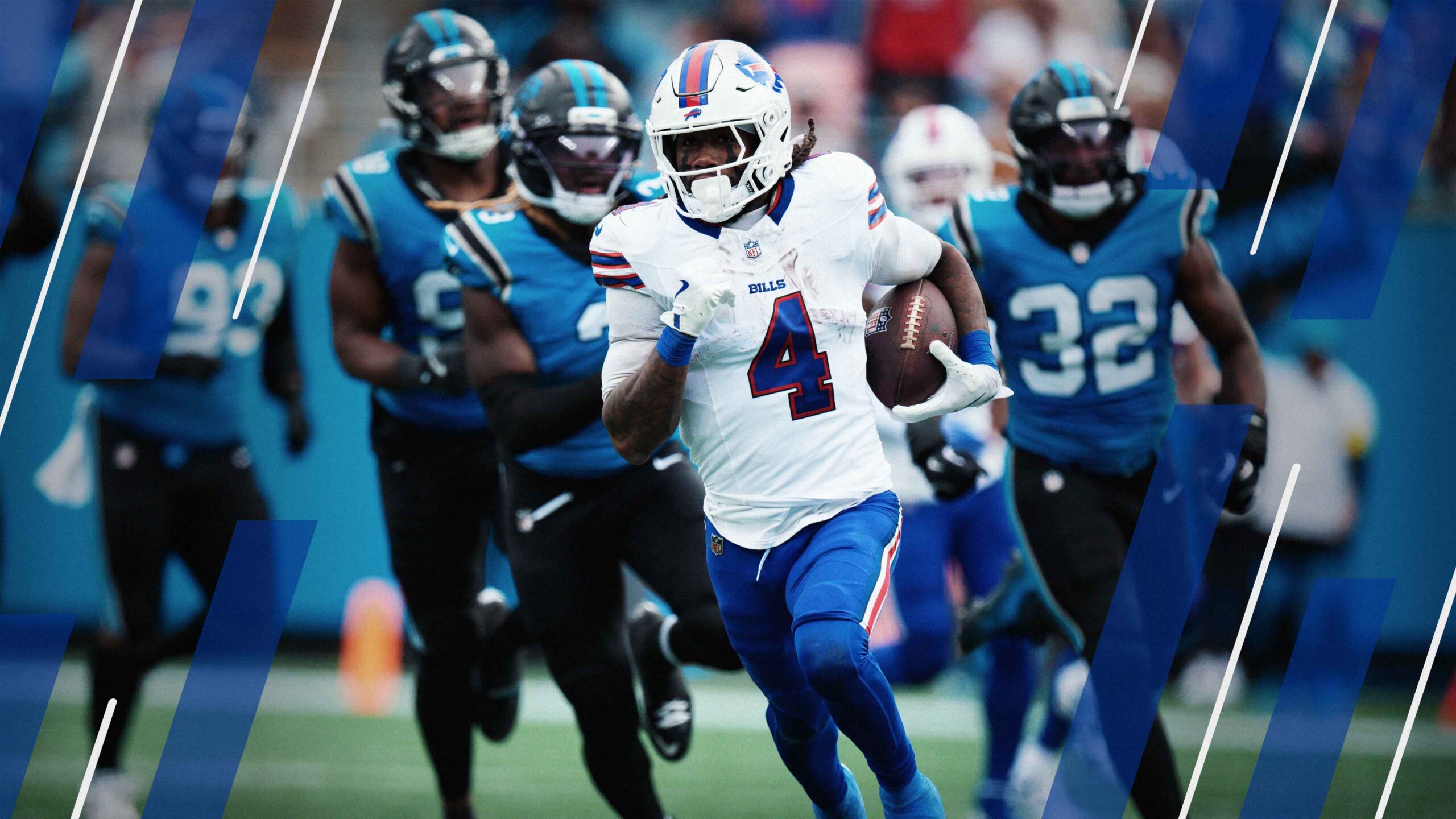Estimated reading time: x minutes
PFF’s fantasy football recap focuses on player usage and stats, breaking down all the vital information you need to achieve fantasy success in 2025.
Miami Dolphins @ Atlanta Falcons
The Falcons adjust without multiple wide receivers: Drake London was inactive due to a hip injury, headlining the Falcons’ struggles at the wide receiver position.
Atlanta’s top three wide receivers last season were London, Darnell Mooney and Ray-Ray McCloud, who all ranked among the top 10 overall wide receivers in offensive snaps in 2024 with over 980 each. The Falcons didn’t make any major changes to the wide receiver room this offseason.
The Falcons waived wide receiver McCloud on Tuesday. He played 981 offensive snaps last season as their third wide receiver, and he played 50% of their offensive snaps over the first four weeks this year. However, he hadn’t played the last two weeks due to what head coach Raheem Morris described as a private matter. He signed with the New York Giants‘ practice squad after his release. London popped up on the injury report on Friday due to a hip injury. He initially wasn’t given an injury designation, but that changed to questionable on Saturday. We didn’t know he was out until the inactives were announced 90 minutes before kickoff.
This moved Mooney to the top of the depth chart, but he’s been dealing with injury all season. He was limited in practice all week with a hamstring injury, and wasn’t given a game status. Last week, London and Mooney were the clear top two wide receivers, while David Sills V essentially played ahead of Casey Washington as the third receiver in three-receiver sets. Washington is a more natural X receiver, which is Mooney’s role. This week, Sills was an every-down receiver. Instead of Washington playing more, KhaDarel Hodge played as the third receiver in three-receiver sets. The Falcons have typically rotated players in the slot, but this week, Sills was the clear slot receiver, while Mooney and Hodge typically played out wide.
Hodge led the wide receiver room in targets, leading to three receptions and 31 yards. If London ends up missing more time, it’s possible that Hodge is the best waiver-wire target on the team.
Dolphins adjust without their top two tight ends: Darren Waller was placed on injured reserve on Wednesday, while Julian Hill was inactive due to an ankle injury.
Miami started the season with a two-man rotation at tight end. Hill played more in run situations, while Tanner Conner played more in passing situations. Waller made his season debut in Week 4, and his playing time increased each week, but a pectoral injury will keep him out until Week 13, at the earliest. Hill also suffered his injury late last week.
This left Conner as the only tight end on the roster, so the Dolphins signed Greg Dulcich off their practice squad, while Hayden Rucci was elevated just for this game. Miami largely stuck with single-tight-end snaps. Conner ended up taking Hill’s role from earlier in the season, while Dulcich took Conner’s role. Conner played more in run blocking situations, while Dulcich was on the field more in passing situations. Despite the snap usage, Conner was the only tight end with targets, catching both passes thrown his way for six yards.
This tight end situation will be one to avoid in most leagues, but if you’re in a very deep league, the usage in this game suggest Dulcich will be the better tight end option until Waller is back.
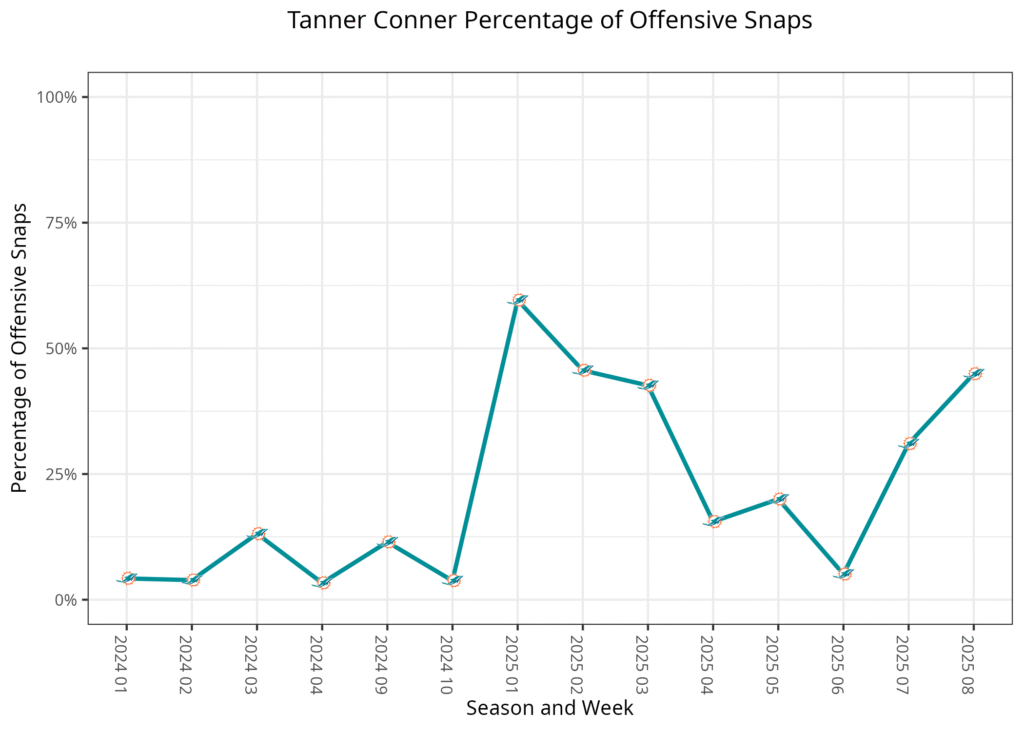
Miscellaneous Notes
- Michael Penix Jr. was limited all week due o a knee injury. He was initially ruled questionable on Friday, but reports made it clear he wasn’t playing Saturday morning. Kirk Cousins took over as the Falcons’ starting quarterback, while Easton Stick was elevated from the practice squad Saturday to be the backup.
- Falcons running back Tyler Allgeier was limited in practice all week due to hip and knee injuries. He was listed as questionable but was ultimately active.
- Bijan Robinson was playing 76.7% of Atlanta’s offensive snaps over the first three quarters, which perfectly matches his average for the season. With the Falcons down several scores in the fourth quarter, Robinson wasn’t used much in the fourth quarter, leading to a season low snap rate.
- The Falcons’ playing from behind also led to a lot more 11 personnel and a lot less 12 personnel, meaning fewer snaps for tight end Charlie Woerner.
- The Falcons elevated wide receiver Dylan Drummond from the practice squad for this game on Saturday.
- The Dolphins started the season with Zach Wilson as their backup and Quinn Ewers as their emergency third-string quarterback. The two switched spots on the depth chart last week, but they flipped back this week.
- Jaylen Waddle showed up on the injury report on Thursday due to a hamstring injury, but he was back to participating fully in practice on Friday.
- Cedrick Wilson Jr. made his season debut with the Dolphins this week. He signed with the team from the New Orleans Saints practice squad after Tyreek Hill landed on injured reserve, but he has been inactive the last three weeks. He emerged as the fourth wide receiver on the depth chart, playing primarily in run situations.
- Dee Eskridge fell to fifth on the depth chart with Wilson active. He was carted off the field due to a shoulder injury in the first half and was ruled out at halftime.
- The Dolphins used backups on the last drive of the game. This is where Jaylen Wright received the majority of his carries.
Chicago Bears @ Baltimore Ravens
Colston Loveland starts for Chicago: Cole Kmet was ruled out due to a back injury after not practicing all week.
The Bears spent the 10th overall pick in the NFL draft on Loveland, but Kmet had been the primary tight end to start the season. Kmet was playing at least 90% of Chicago’s offensive snaps in each of the first four weeks, while Loveland mostly played in two-tight-end sets. In the last two weeks, the tight ends started rotating much more frequently. With Kmet out this week, Loveland was given a chance to have a career-high in snaps. Durham Smythe moved up to second on the depth chart, while Stephen Carlson was elevated from the practice squad.
The good news is Loveland played 81% of the Bears’ offensive snaps. They trusted Loveland with 100% of the snaps on third downs and in two- and three-tight-end sets. The only time he was occasionally substituted out was on early downs in single-tight-end sets, primarily to put Smythe on the field for his blocking. This allowed Loveland to be on the field for 78% of the Bears’ pass plays, which was third best among Bears skill players and much better than Loveland’s past games. He caught three passes for 38 yards. Ideally, given how many pass plays Chicago ran, he would have received a higher target rate. All three wide receivers earned notably more targets than Loveland.
This game was more positive than negative for Loveland, but we are still a little ways away from Loveland potentially being in fantasy starting lineups in most leagues.
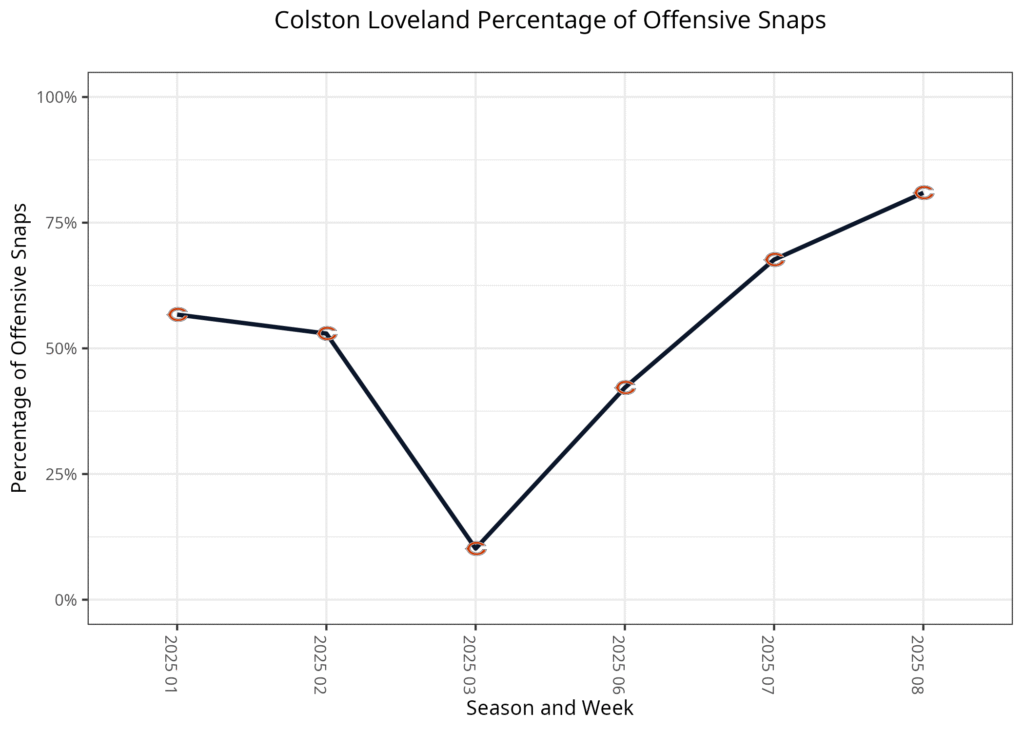
Monitor Luther Burden III’s health: Burden suffered a concussion early in the third quarter and was ruled out in the fourth.
Burden has spent all season as the Bears’ fourth wide receiver. He’s been their primary wide receiver in single-receiver sets and consistently plays in four-receiver sets. However, in more common offensive packages, he has typically played around 20% of Chicago’s offensive snaps.
This week, Burden was playing a little more often than usual before the injury. He played 32.2% of the first-half snaps, up from his previous high of 28.9% last week. He played three snaps out of 12 personnel compared to D.J. Moore‘s two. After the injury, Rome Odunze became the primary wide receiver in single-receiver sets. Moore started playing more frequently in two-receiver sets, while Devin Duvernay became the primary backup in three-receiver sets and the fourth receiver in four-receiver sets.
If Burden misses next week, it should be a little safer to put Moore in fantasy starting lineups. Moore had his best game of the season with four receptions for 73 yards.
Patrick Ricard makes his season debut: The Ravens fullback missed the first seven weeks of the season due to a calf injury.
The Ravens spent their first six games without a true fullback on the roster, so Zaire Mitchell-Paden often lined up at fullback when they wanted to use a tight end in the backfield. This allowed Baltimore to use a tight end rotation very similar to last season’s.
Isaiah Likely and Charlie Kolar played in 22 personnel, as they did last year. Baltimore typically used a rotation of tight ends in 21 personnel, led by Kolar. This week, Kolar took all nine snaps. In 12 personnel, Likely played 20 of 21 snaps, Mark Andrews played 17, and Kolar played five. Typically, Andrews played a higher percentage of those snaps last season. In 11 personnel, Andrews led the way with 15 snaps, compared to Likely’s six and Kolar’s one. However, Andrews was used as a blocker on more than half of his snaps out of 11 personnel.
If the Ravens continue using this rotation, then Andrews and Likely’s fantasy potential will be nearly identical. Andrews caught all three of his targets this week, while Likely did last week. It will generally be difficult to trust either tight end as long as they are both healthy, particularly with Kolar playing more than last season. However, the Ravens have the clear top schedule for tight ends over the rest of the season, particularly in the fantasy playoffs. It will be worth keeping an eye on the rotation because it’s possible Andrews or Likely could be a league winner this season if they can take a stronger hold of the receiving tight end job.
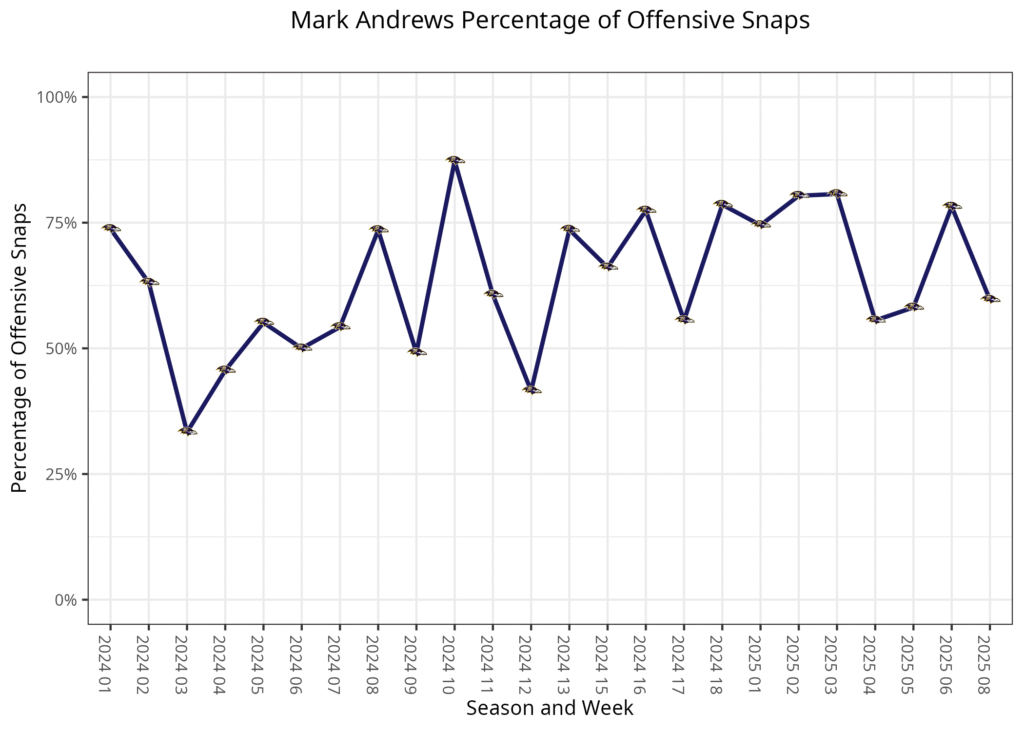
Miscellaneous Notes
- Chicago running back D’Andre Swift has either been limited or hasn’t practiced in each of the last five practices due to a groin injury. He was listed as questionable for a second straight week but played through the injury. He and Kyle Monangai were even closer to a 50-50 split this week than last week, but Swift continues to be more involved when he is on the field compared to Monangai when the rookie is playing.
- Roschon Johnson was ruled out on Friday due to a back injury after not practicing all week.
- Bears wide receiver D.J. Moore didn’t practice on Wednesday, was upgraded to a limited participant on Thursday and upgraded again to full participant on Friday. He is dealing with a hip injury.
- Bears wide receiver Jahdae Walker was active this week after two straight healthy scratches.
- Bears’ kicker Cairo Santos returned after missing the last two games due to a right thigh injury.
- Baltimore quarterback Lamar Jackson was limited in practice all week due to a hamstring injury. He was initially listed as a full participant on Friday with no injury designation, but they changed his Friday designation to limited on Saturday and also ruled him out. Baltimore signed Tyler Huntley off their practice squad on Friday to start this week.
- Ravens’ third-string running back Keaton Mitchell doubled his offensive snaps on the season with seven. He ran four times for 43 yards, in part thanks to a 25-yard run.
- DeAndre Hopkins played a season-high 37.1% of Baltimore’s offensive snaps, which included 100% of the snaps in three-receiver sets.
- The Ravens waived tight end Zaire Mitchell-Paden on Thursday, potentially because of Ricard’s return. They weren’t able to retain him for their practice squad, as the New Orleans Saints claimed him.
- Baltimore wide receiver Devontez Walker couldn’t play due to an oblique injury, his second straight absence. He was a full participant all week and wasn’t given a game status, making it somewhat surprising that Walker was inactive.
Buffalo Bills @ Carolina Panthers
The Panthers continue their frustrating running back rotation: Rico Dowdle gained more rushing yards than Chuba Hubbard, finishing with more yards per carry despite being the backup for a second straight week.
Carolina started the season with Hubbard as its early-down back, while Dowdle was the receiving back and primary backup on early downs. Hubbard missed two weeks due to injury, and in that time, Dowdle ran 53 times for 389 yards and a touchdown while catching seven passes for 84 yards and a touchdown. This led Carolina to use a rotation by drive in Hubbard’s first game back last week. Hubbard played the first drive, Dowdle played the second, and so on. The only exceptions were on longer drives, when they wanted to give a break to the running back on that drive.
This week, it was the same story. There was only one drive where both running backs saw the field. With the game out of reach in the fourth quarter, Trevor Etienne took the 11th drive of the game. The only difference this week was that Hubbard happened to be on the field for longer drives, while Dowdle was there for shorter ones. One of Dowdle’s five drives consisted of Andy Dalton losing a fumble on a sack on the first play, while another two drives were three-and-outs. This meant there were only two drives where Dowdle was on the field for more than three plays, compared to Hubbard’s four longer drives.
It’s understandable that the Panthers didn’t want to have Hubbard lose his starting job due to injury while Dowdle dominated two favorable matchups. However, now Carolina has had back-to-back games where Dowdle has averaged more than double Hubbard’s yards per carry. Ideally, Dowdle will start for the team next week. Dowdle should be considered a buy-low option this week, given that he will still typically play at least 50% of the team’s offensive snaps if they don’t change the rotation and more than 50% if they do.
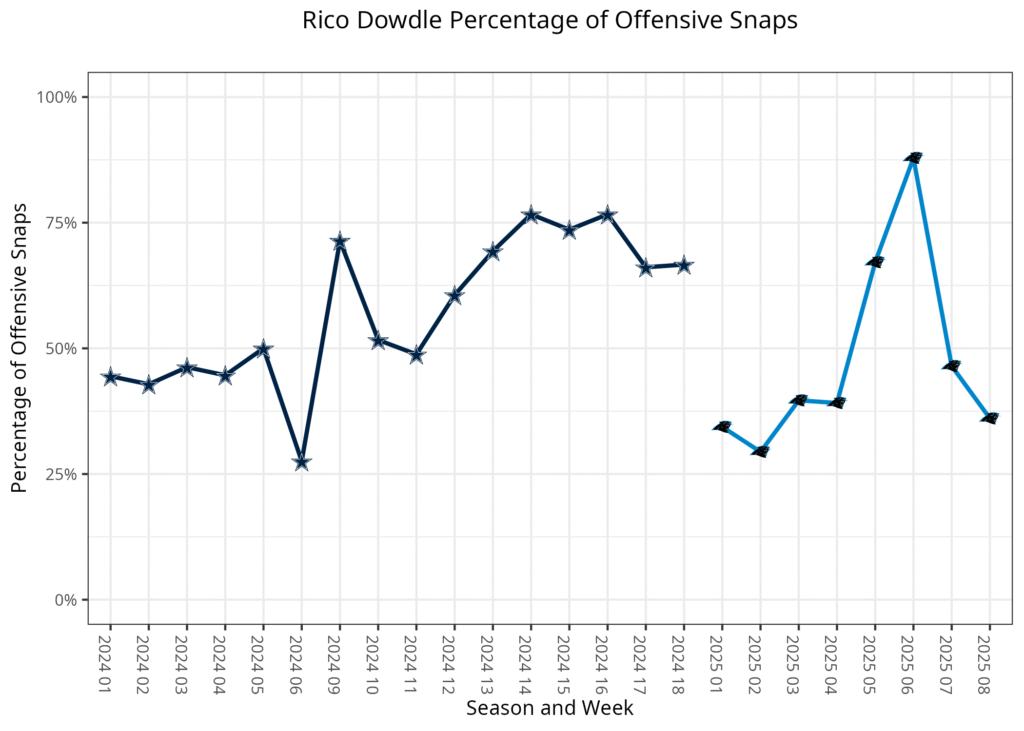
Jalen Coker takes on a larger role: Coker was rotating in three-receiver sets much less frequently than last week.
Coker suffered a quadriceps injury in August, leading him to spend the start of the season on injured reserve. He began last week as a rotational player in three-receiver sets. By the fourth quarter, the Panthers began trusting Coker more regularly in three-receiver sets.
This week, he picked up where he left off last week. He played 82% of the snaps in three-receiver sets compared to 60% last week. He also took two snaps out of two-receiver sets, replacing Xavier Legette, after not playing at all in two-receiver sets last week. Coker caught three passes for 36 yards, while Legette caught two passes for 17 yards. There is still time for Coker’s role to increase this season. He is a fine speculative waiver-wire addition. He will likely need to take many more snaps from Legette in two-receiver sets before he starts being used in fantasy starting lineups.
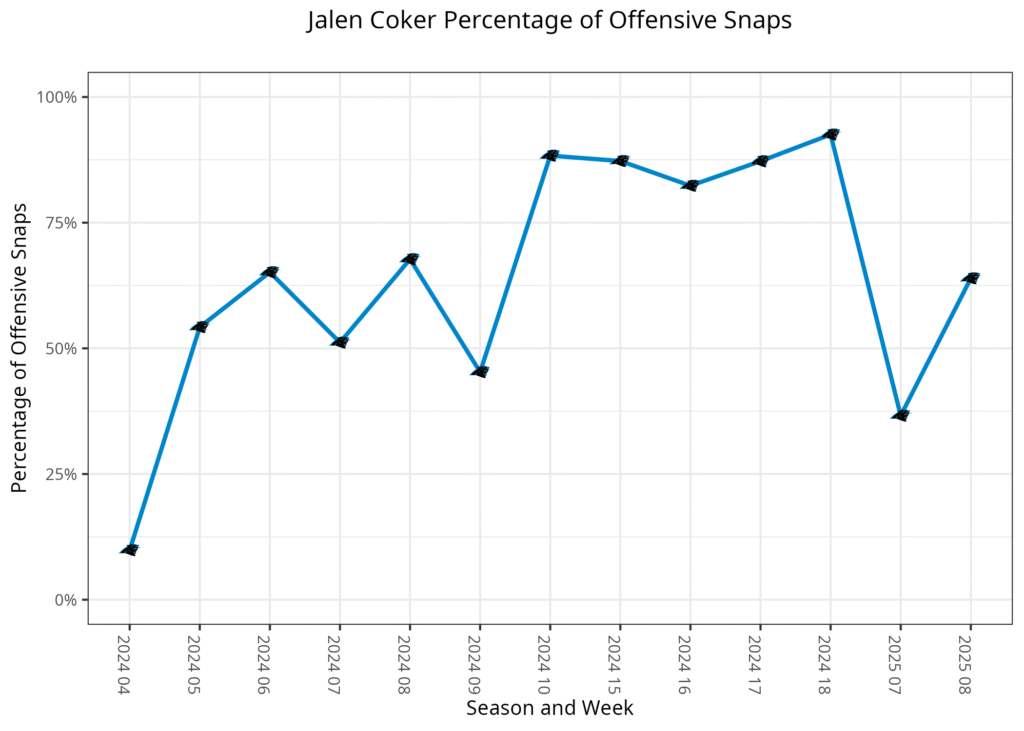
Dalton Kincaid plays 14 snaps in a blowout victory: Kincaid typically plays less when the Bills are winning, but this game was a new extreme.
Kincaid spent the first two years of his NFL career in a frustrating rotation with Dawson Knox, making it hard to trust Kincaid in fantasy starting lineups. This season, Kincaid’s yards per route run are up significantly from the last two seasons. He already has more explosive plays this season than last. However, the tight end rotation is even more frustrating, thanks to rookie Jackson Hawes‘ emergence. Hawes is the Bills’ highest graded tight end this season. He has much higher run-and pass-blocking grades than Kincaid and even a higher receiving grade, albeit on a much smaller sample size.
Kincaid had hovered around 42-58% of the offensive snaps on two-tight-end sets this season, but that was down to 9.1% in this game. Buffalo leaned on Knox and Hawes and its run blocking in that personnel grouping. On early downs in single-tight-end sets, the Bills also leaned on Knox and Hawes more than Kincaid, who was still on the field for 50% of the single-tight-end snaps on third downs, which was normal for him. Kincaid still led the Bills tight ends in routes run, as Buffalo passed the ball on 13 of Kincaid’s 14 snaps.
While there is always a chance Kincaid makes a big play, it will remain very difficult to trust him in games where the Bills are clear favorites due to how Kincaid is used in these game scripts.
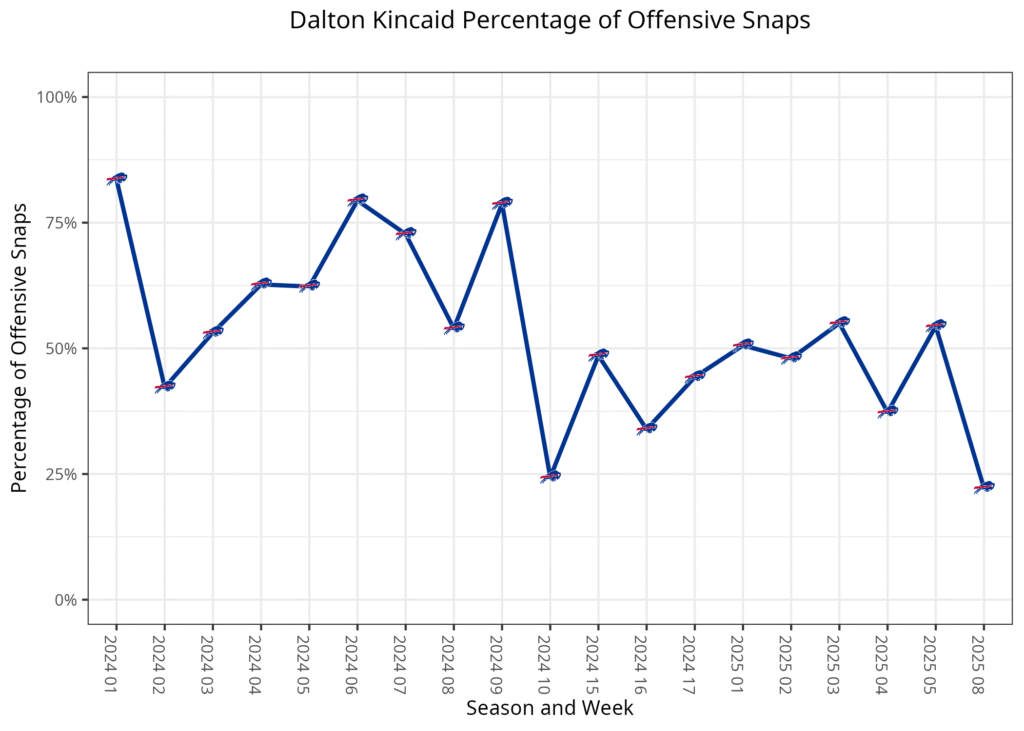
Miscellaneous Notes
- James Cook III ran for a career-high 216 rushing yards. It was only his second game above 140 rushing yards in his career.
- Bills wide receiver Joshua Palmer was ruled out on Friday due to knee and ankle injuries. He didn’t practice all week.
- Curtis Samuel was active this week after missing last week due to neck and ribs injuries. He was limited in practice to start the week but was able to practice in full by the end of the week.
- Tyrell Shavers played 12 of a possible 14 offensive snaps in two-tight-end sets after not playing any of those snaps the last two weeks. However, he played less in three-receiver sets in recent weeks, allowing Elijah Moore and Samuel to primarily replace Palmer in those sets.
- Buffalo tight end Dalton Kincaid returned after missing last week due to an oblique injury. He was limited in practice all week and was initially ruled questionable.
- Panthers quarterback Bryce Young couldn’t play due to an ankle injury. Andy Dalton took over as the starter, while Hendon Hooker was elevated from the practice squad to be a backup.
- Jimmy Horn Jr. was ruled questionable due to an ankle injury late in the second quarter, but he was able to return before the end of the third quarter.
- The Panthers’ healthy inactives this week included halfback DeeJay Dallas, wide receiver Hunter Renfrow and tight end James Mitchell. All three were also inactive last week, corresponding with the returns of Chuba Hubbard, Jalen Coker and Ja’Tavion Sanders.
- Sanders received a notable increase in snaps in his second week back, up to 54.1%. However, he’s played in less than 50% of the snaps in two-tight-end sets in four of five games this season and under 60% of the snaps in single-tight-end sets on early downs on all five games. It will be difficult for him to be a consideration in fantasy football without higher rates in both situations.
New York Jets @ Cincinnati Bengals
The Jets play without their top two wide receivers: Garrett Wilson (knee) and Josh Reynolds (hip) were both unable to practice all week.
Wilson was ruled out on Friday, while Reynolds was placed on injured reserve on Saturday. They had been the top two wide receivers on the depth chart, when healthy. Arian Smith, Allen Lazard and Tyler Johnson had all played some this season as the third wide receiver, but there was little consistency from one week to the next. All three were needed in larger roles this week. New York also signed Brandon Smith off the practice squad to replace Reynolds’ roster spot.
The Jets turned to Lazard as the X receiver and Johnson as the Z receiver in both two- and three-receiver sets. While it seemed like Smith would be the clear choice to also play in three-receiver sets, instead, Isaiah Williams emerged as the primary slot receiver. Smith still played some snaps in three-receiver sets and was the typical single receiver in one-receiver sets.
Lazard has been the constant subject of trade rumors since Aaron Rodgers left New York, but a trade seems unlikely given his current role. He is replacing the player who landed on injured reserve. The Jets also don’t appear comfortable giving their fourth-round rookie a larger role despite the two injuries. Unless someone makes a great offer, we should expect Lazard to remain in New York. Johnson had the best day of the Jets receivers with three receptions for 64 yards and a touchdown. However, he did this in Wilson’s role, and we can expect a decrease in snaps by Reynolds once Wilson is back.
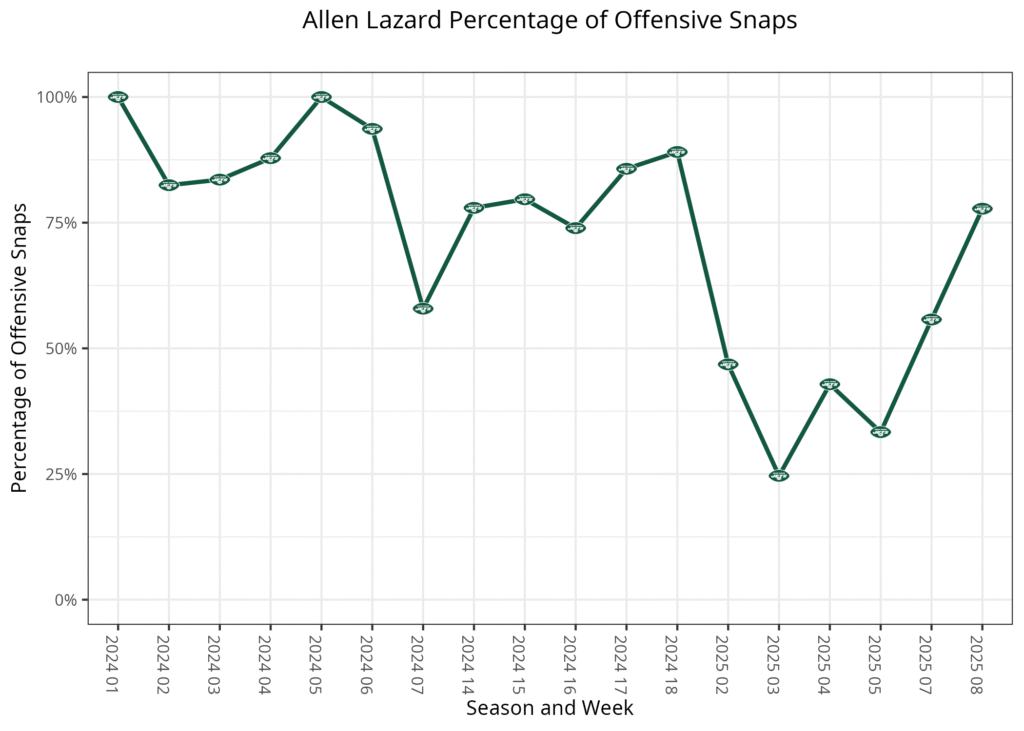
Samaje Perine leads the Bengals in rushing yards: Perine’s role in the offense has grown in recent weeks, leading to his best rushing performance since 2022.
The Bengals’ rotation at running back was very predictable early in the season. Chase Brown played 88.5% of Cincinnat’s snaps in normal early-down situations in Weeks 1, 2 and 4, ignoring Week 3 when Perine was injured. Perine played 82.6% of the third-down snaps during the same time span. In Weeks 5 and 6, Perine played nearly as many snaps as Brown. This was largely from the team playing from behind, but Brown’s snaps on early downs dipped to 82.6% in that time.
Last week, the Bengals found much more success running the ball compared to other recent weeks. Brown ran the ball 11 times for 108 yards, while Perine ran seven times for 31 yards. Perine’s playing time increased even more on early downs. However, a lot of those snaps occurred after Brown had a long run and needed a break. This week, Perine played 29.3% of the early-down snaps, up significantly from every other game this season. Brown was still the leader on early downs and had a great game with 12 carries for 73 yards and a touchdown in addition to three receptions for 32 yards and another score. Perine ran nine times for 94 yards and a touchdown.
It seems unlikely that Perine will overtake Brown anytime soon. However, it’s becoming clear that if Brown suffers an injury, Perine would have a significant role on early downs. Given his recent success and how little Tahj Brooks has been involved this season, Perine appears to be the better handcuff option. The Bengals also have the best schedule for running backs over the rest of the season, including a three-game stretch facing the Baltimore Ravens, Buffalo Bills and Ravens again. We could see Perine become the better fantasy option, given the potential game script of those games.
Typically, when a receiving back has a big game out of nowhere, it’s best to avoid them on the waiver wire. However, given the recent usage changes and Bengals’ schedule, you should make an exception to that rule for Perine.
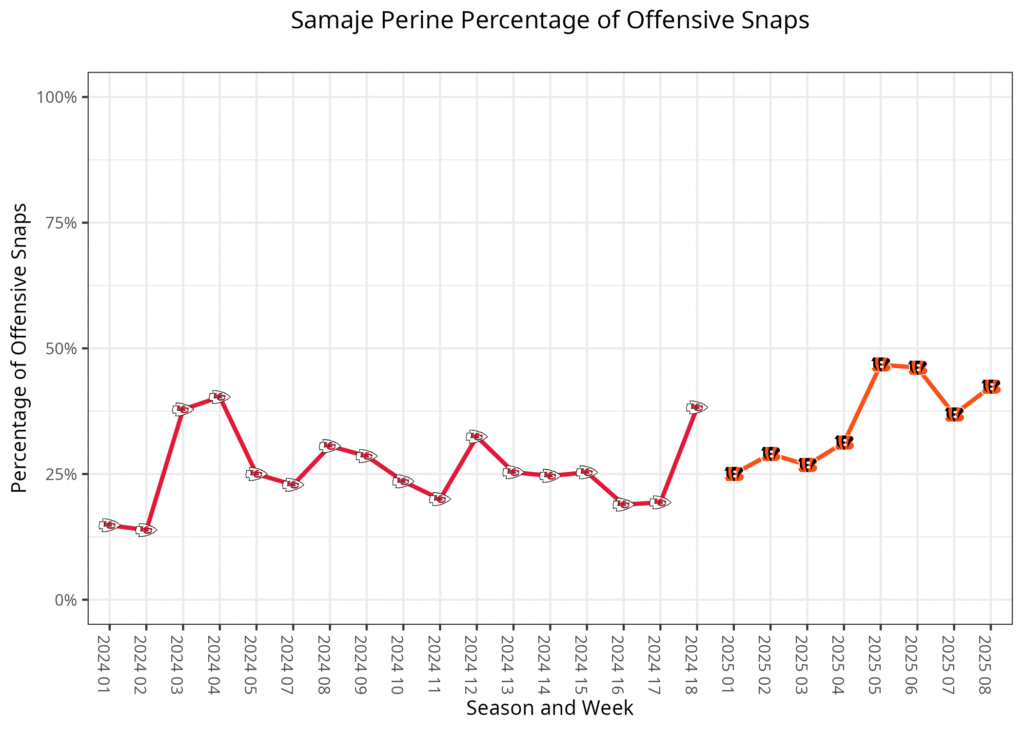
The Bengals adjust their tight end rotation: Tanner Hudson returned after missing last week due to a concussion.
Cincinnati has been a rare team to keep five tight ends on the roster. Drew Sample has been its primary blocking tight end, Mike Gesicki has been the primary receiver, and Noah Fant has played in two-tight-end sets with a remarkably high targets per route. Hudson has been a primary receiving backup and Cam Grandy has been a primary blocking backup.
Gesicki landed on injured reserve after Week 6 due to a pectoral injury. We didn’t get a chance to see how snaps would be distributed between Fant and Hudson last week because Hudson was out due to a concussion. Hudson was back this week, leading Grandy to be a healthy inactive.
The Bengals used Sample and Fant as the primary tight ends in two-tight-end sets while splitting the single-tight-end work on early downs. Hudson was the primary tight end for third downs, similar to Gesicki. Hudson caught a pass for nine yards, while Fant caught three passes for 41 yards. Fant will be fine in very large leagues, but it will be difficult to trust him in most normal leagues without him having a larger role in clear passing situations.
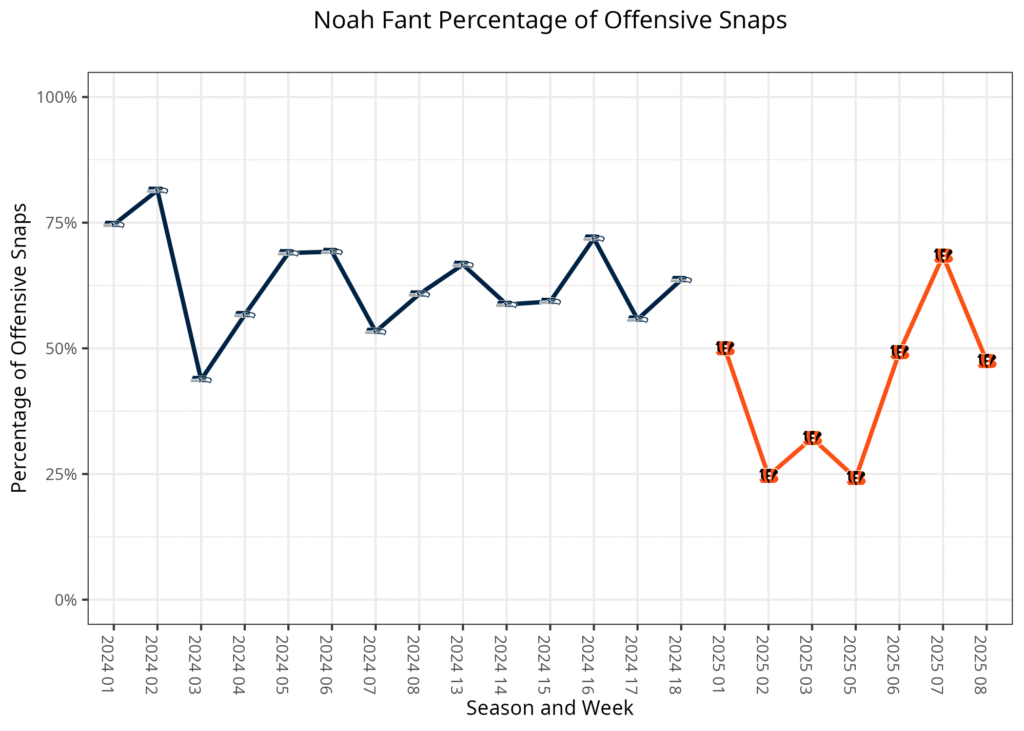
Miscellaneous Notes
- New York quarterback Tyrod Taylor couldn’t play due to a knee injury. He was initially listed as questionable on Friday then changed to out on Saturday. He was expected to replace Justin Fields as the starter if he could have played. This left Fields as the starter, while Brady Cook was a practice squad elevation to be the backup.
- Jets running back Breece Hall was limited in practice due to a knee injury on Wednesday and Thursday. He was upgraded to full on Friday and ruled questionable, but he ultimately played.
- Hall has played 55% of the Jets’ offensive snaps over the last two weeks, largely because the Jets have been playing from behind. Isaiah Davis has been the third-down and two-minute-drill back. Assuming Hall doesn’t get traded, he should play a higher percentage of the offensive snaps if the Jets can stay even or gain a lead in a game in the future.
- New York halfback and returner Kene Nwangwu was ruled out Friday due to a concussion. He didn’t practice all week.
- New York tight end Mason Taylor was added to the injury report on Thursday due to a quadricep injury. He was limited in practice on Friday and ruled questionable but ultimately played. Taylor played 76.4% of the offensive snaps this week after playing over 93% each of the last two weeks. That was still enough time for him to catch five passes for 34 yards and a touchdown.
- Backup tight end Stone Smartt was ruled out due to a quadricep injury. This led Jelani Woods to be active this week after four straight games as a healthy inactive.
San Francisco 49ers @ Houston Texans
Houston plays without their top two wide receivers: Nico Collins (concussion) and Christian Kirk (hamstring) were both inactive after missing practice all week. This was Kirk’s second consecutive missed game.
The Texans typically use Collins and Jayden Higgins in two-receiver sets, while Collins, Xavier Hutchinson and Kirk were on the field in three-receiver sets. When the Texans didn’t have Kirk last week, they used a two-man rotation with Braxton Berrios and Jaylin Noel. The third-round rookie caught four passes for 77 yards, which was 50 more than any other wide receiver last week. With both receivers out, the Texans elevated Jared Wayne from the practice squad.
On the outside, Higgins and Hutchinson were both more involved, but not as much as some fantasy managers would like. Higgins remained one of the two wide receivers in two-receiver sets, but Wayne was the other primary player in that personnel grouping. In three-receiver sets, Higgins played the majority of the snaps, which was a notably more than usual. Hutchinson was rotated out less frequently in three-receiver sets, while was also notably more for him. However, Wayne also played 24.5% of the snaps in three-receiver sets.
In the slot, Houston continued to rotate Noel and Berrios. Noel played 20 snaps in the first half compared to Berrios’ 17, as both players ran 14 routes. Berrios suffered a chest injury in the third quarter but was able to return later in the fourth quarter. This led Noel to play 11 snaps compared to Berrios’ six in the second half. The Texnas had a lead, so they didn’t need as much 11 personnel that half.
Hutchinson, Noel, Higgins and Berrios all had at least eight PPR points each in this rotation. We can expect the outside wide receiver rotation to be the same as it was once Collins is back. It will be curious to see how much Noel remains involved, given his recent success, once Kirk is back.
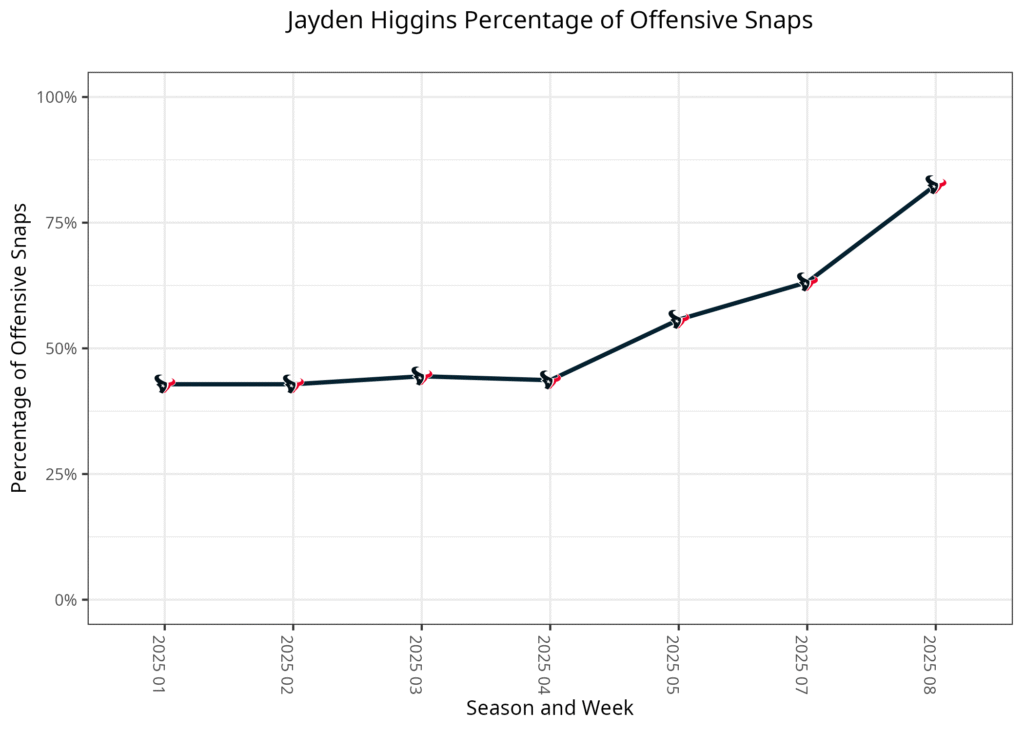
George Kittle is close to normal: Kittle scored a touchdown on National Tight End Day and played more this week than last.
Kittle suffered a hamstring injury early in Week 1, causing him to miss the first third of the season. He returned last week but only played 81.8% of the 49ers’ offensive snaps and was held without a reception. It was the first game of his NFL career where he was held without a catch.
This week, he played in 43 of a possible 48 offensive snaps. The 49ers used single-tight-end snaps for 46 of their 48 plays, so there weren’t as many snaps for tight ends to go around compared to usual. Kittle caught four passes for 43 yards and a touchdown. His primary receiving backup, Jake Tonges, also scored a touchdown. It happened to occur on the one play where the 49ers used a three-tight-end set.
Kittle can safely be put back in fantasy starting lineups going forward.
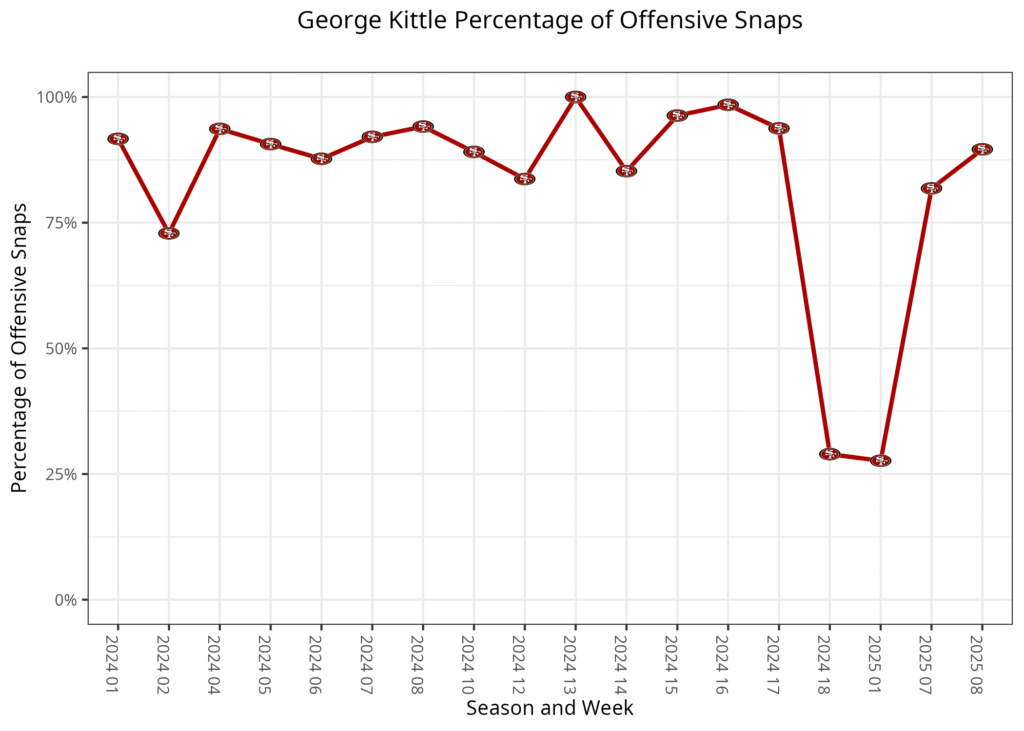
Miscellaneous Notes
- Houston running back Dameon Pierce returned after a healthy scratch last week. He didn’t play an offensive snap.
- Woody Marks was back to playing 40% of the Texans’ offensive snaps this week, which is around his season average. This was in part because Dare Ogunbowale is back to playing on third downs, similar to last week.
- Tight end Dalton Schultz was limited on Wednesday and Thursday due to a shoulder injury, but he was upgraded to a full participant in Friday’s practice. He was rotated out slightly more often this week than usual, finishing with a 61.2% snap rate.
- The Texans waived tight end Brenden Bates on Saturday. This left Houston with only two tight ends on the roster, although fullback Andrew Beck can also play tight end.
- 49ers’ quarterback Mac Jones was a full participant in practice all week due to knee and oblique injuries and wasn’t given a game status.
- Brock Purdy was ruled out due to a toe injury, his third straight absence. He was limited in practice all week.
- Christian McCaffrey played a season-high 95.8% of the 49ers’ offensive snaps this week.
- Wide receiver Ricky Pearsall didn’t practice all week and missed his third straight game due to a knee injury. He was ruled out on Friday.
- Jauan Jennings was a full participant in practice all week despite ankle, rib and shoulder injuries and wasn’t given a game status.
- Fourth-round rookie Jordan Watkins made his NFL debut after missing the first five games either due to injury or as a healthy inactive.
- This was the first time all season that the 49ers had the same top three wide receivers as the previous week. Jennings and Kendrick Bourne were the top wide receivers, while Demarcus Robinson joined them for three receiver sets.
- The 49ers waived tight end Brayden Willis on Monday, with George Kittle fully healthy. He was signed to their practice squad on Tuesday.
Cleveland Browns @ New England Patriots
Monitor Quinshon Judkins health: Judkins suffered a shoulder injury in the third quarter and was ruled out at the start of the fourth quarter.
The Browns had settled into a predictable running back rotation in recent weeks, as Judkins played over 75% of the early-down snaps, while Jerome Ford played in clear passing situations, and Dylan Sampson backed Judkins up. That’s what Cleveland did for the first 35 minutes of this game. Judkins wasn’t finding much success against the Patriots’ defense, running nine times for 19 yards and catching three passes for -2 yards.
After the injury, Sampson became the primary running back, playing 19 of a possible 27 snaps to close out the game. Sampson was similarly the Browns’ primary running back early in the season before Judkins was on the 53-man roster. It’s unclear how severe Judkins’ injury is, as the game script could have impacted the Browns’ decision to rule Judkins out. The Browns also have their bye week next week, so we might not have a great sense of how serious the injury is for at least another week.
Sampson is worth picking up off the waiver wire just in case Judkins misses time. The Browns have the fourth-best schedule for running backs over the rest of the season, including a game against the New York Jets in Week 10. Sampson could be a regular fantasy starter for as long as Judkins is out, if he misses any time. Ford had been the subject of trade rumors, and this could impact Ford’s chances of getting traded.
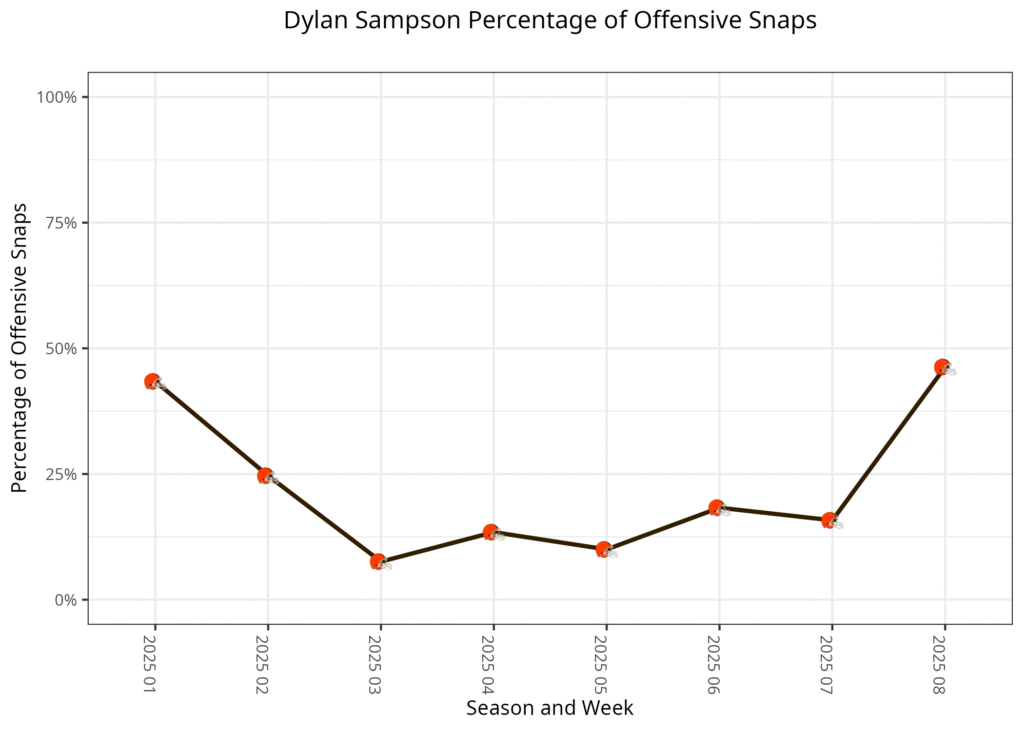
Gage Larvadain enters the Browns’ wide receiver rotation: The undrafted rookie wide receiver has seen his playing time increase significantly every week over the last month.
The Browns started the season with Jerry Jeudy and Cedric Tillman as their primary receivers, while Isaiah Bond and Jamari Thrash fought for the slot snaps in three-receiver sets. Once Tillman went down due to an injury, Bond and Thrash were able to play more. Cleveland also turned to even more two-tight-end sets.
Tillman’s injury also allowed Larvadain a chance to be on the 53-man roster. He played one offensive snap in Week 5 and then became a backup in three-receiver sets in Week 6. He played notably more snaps in Week 7 because he started playing in single-receiver sets. This week, he played 61.5% of the snaps in three-receiver sets, which was a little more than Bond, who remained a primary wide receiver in two-receiver sets, while Thrash played the second-most snaps in three-receiver sets. This kind of rotation with a different wide receiver in two-receiver sets compared to three makes for a nightmare for fantasy purposes.
Larvadain was held without a target and should only be considered in very deep fantasy leagues. However, his increase in snaps makes it harder for Bond to break out. Bond was also held without a catch this week. The situation will become even more complicated once Tillman is able to return from injured reserve.
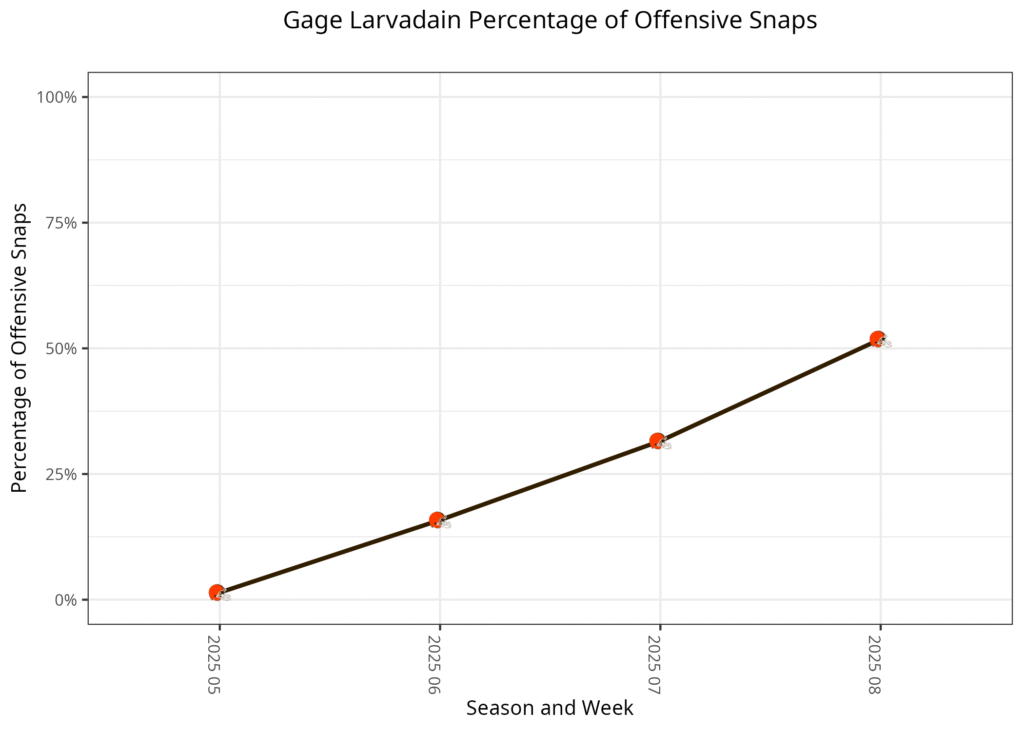
David Njoku returns in a limited role: Njoku was back in the lineup after missing last week due to a knee injury. He was limited in practice all week and was initially listed as questionable.
Njoku spent the first six weeks of the season playing 76.7% of the Browns’ offensive snaps. He and rookie Harold Fannin Jr. typically shared the field in two-receiver sets. Njoku played 62.7% of the early-down snaps while splitting snaps 50-50 with Fannin on third downs.
This week, Njoku was rotated out more than usual in two-tight-end sets. Blake Whiteheart took eight snaps from Njoku in these situations. Fannin and Njoku were also in a 50-50 split on early downs in single-tight-end sets, which was good news for Fannin’s fantasy value. Fannin led the team in receiving with six receptions for 62 yards and a touchdown, while Njoku wasn’t far behind with four receptions for 37 yards and a score.
Njoku has been the subject of trade rumors. The Browns have their bye week this week, so if Njoku gets traded, this would be his last game with the team. It’s more likely Njoku would lose fantasy value rather than gain it with a new team, as he would likely have more competition for targets with a new team.
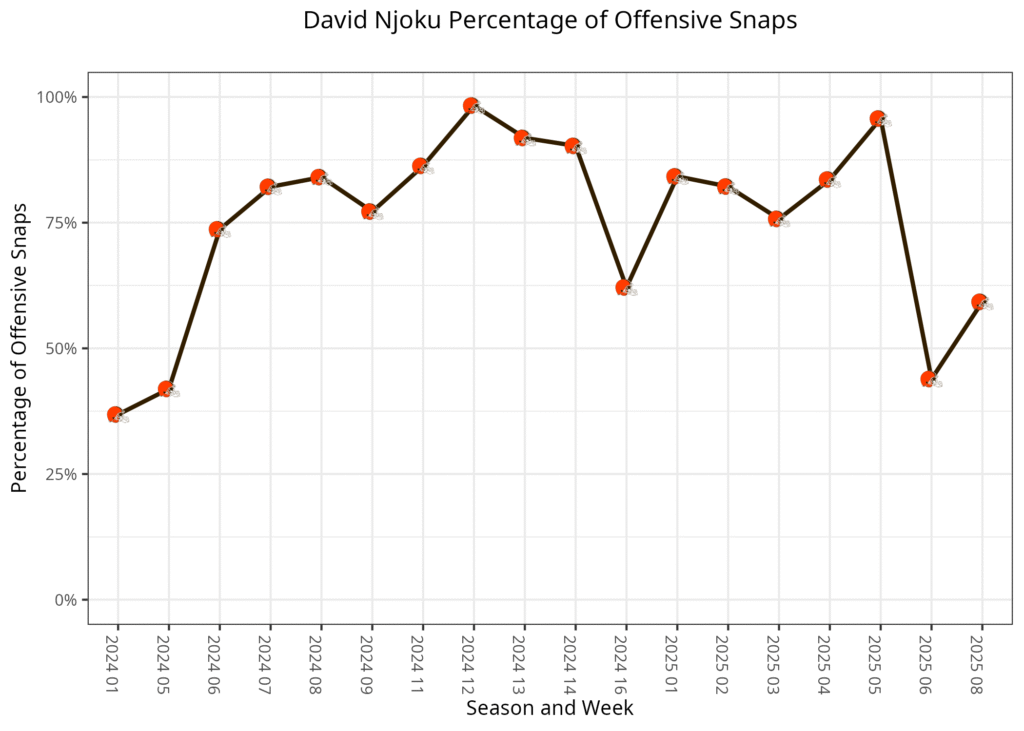
TreVeyon Henderson shines despite smaller role: Henderson led the Patriots in rushing yards with 75 on 10 carries.
The Patriots started the season using three running backs in Rhamondre Stevenson, Henderson and Antonio Gibson, who suffered a season-ending injury in Week 5, which seemed like an opportunity for Henderson to get more involved in the offense. In Week 6, Henderson had more rushing yards than Stevenson despite carrying the ball less.
Surprisingly, Stevenson played 49 offensive snaps in Week 7, compared to Henderson’s nine snaps. This was a clear career low for Henderson, and there is no obvious reason why this occurred. Stevenson had a fine day running the ball with 18 carries for 88 yards and a touchdown that week. This week, Stevenson played 50 snaps to Henderson’s 14. The good news is that Henderson touches the ball on the clear majority of his snaps, and he played well in those opportunities. His 75 rushing yards this week were more than double his previous career high.
It’s probably too early to put Henderson in fantasy starting lineups, given his low snap rate the last two weeks. This game was a good sign that Henderson should see a larger role going forward.
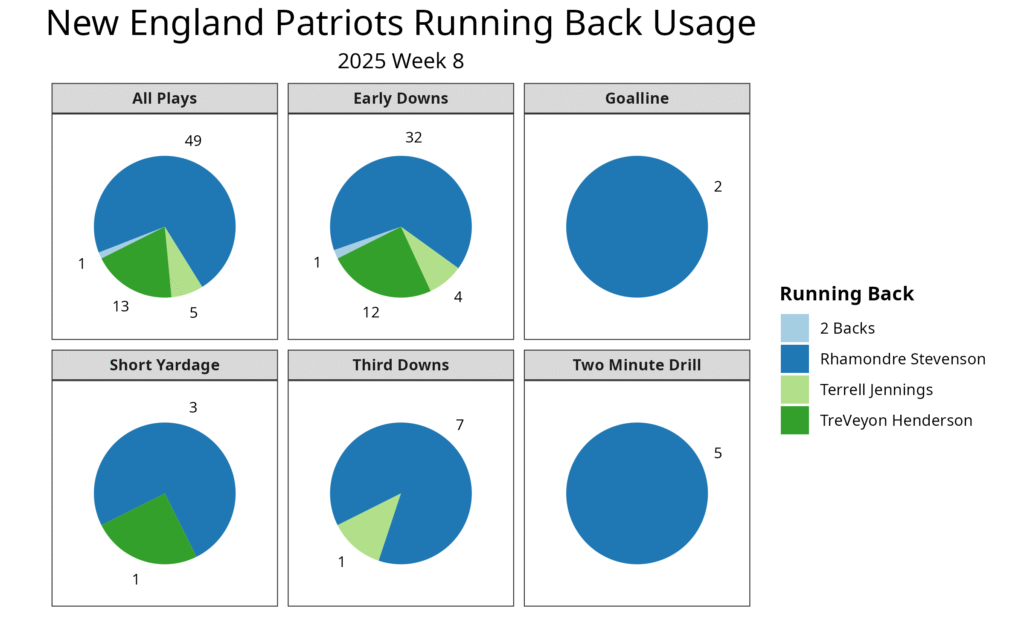
Miscellaneous Notes
- Browns’ quarterback Shedeur Sanders couldn’t play due to a back injury. He only appeared on the injury report on Saturday. Cleveland elevated Bailey Zappe off the practice squad to be the backup quarterback this week.
- Browns wide receiver Jerry Jeudy didn’t practice on Wednesday but was limited on Thursday and Friday due to a knee injury. He wasn’t given a game status.
- The Patriots elevated running back Terrell Jennings from the practice squad for this game on Saturday. It was his third straight practice squad elevation, so the Patriots have to sign him to the 53-man roster if they want to play him again.
- Stefon Diggs was limited in practice on Wednesday and Thursday due to a chest injury, but he was able to practice in full on Friday. Diggs played under 50% of New England’s offensive snaps for the first time this season. This was just as likely to do with the game script as it did Diggs’ injury. Diggs has played 40% of the snaps in two-receiver sets this season, and New England used more two-receiver sets this week due to the blowout victory.
- Patriots rookie wide receiver Efton Chism III was a healthy inactive after suiting up last week.
- Tight end Hunter Henry notably played 34.8% of the snaps in two-tight-end sets last week after playing 91.4% the first six weeks. He plated 60.7% of those snaps this week. While part of his low snap rate the last two weeks has been garbage time, he’s played under 80% before garbage time each of the last two weeks after playing over 80% in five of the first six weeks.
New York Giants @ Philadelphia Eagles
Monitor Cam Skattebo’s health: Skattebo suffered what appeared to be a season-ending ankle injury.
Skattebo had emerged as the Giants’ clear lead running back in recent weeks, finishing with 15 or more carries in each of the last four games. He played in 11 of the first 16 snaps in this game, as the Giants focused on passing the ball early. Skattebo’s injury occurred on a target where his foot got caught under a defender and was clearly dislocated. While there has been no official word on the extent of the injury, he was taken to the hospital, and the general consensus is he will miss the rest of the season due to the injury.
Tyrone Tracy took 28 of the final 36 snaps of the game as the Giants’ primary running back in both run and pass situations. Tracy is available in 58% of ESPN leagues and will be the obvious top waiver-wire target in any league where he’s available. Devin Singletary moved from third to second on the depth chart and took the rest of the snaps. Singletary should be picked up in any deeper league where all clear backups are taken. Singletary had been the subject of trade rumors prior to this game, but the injury to Skattebo makes it very unlikely that Singletary gets traded.
It’s at least possible the Giants will look to trade for a running back, but they might be fine with the same running back pair they used all of last season.
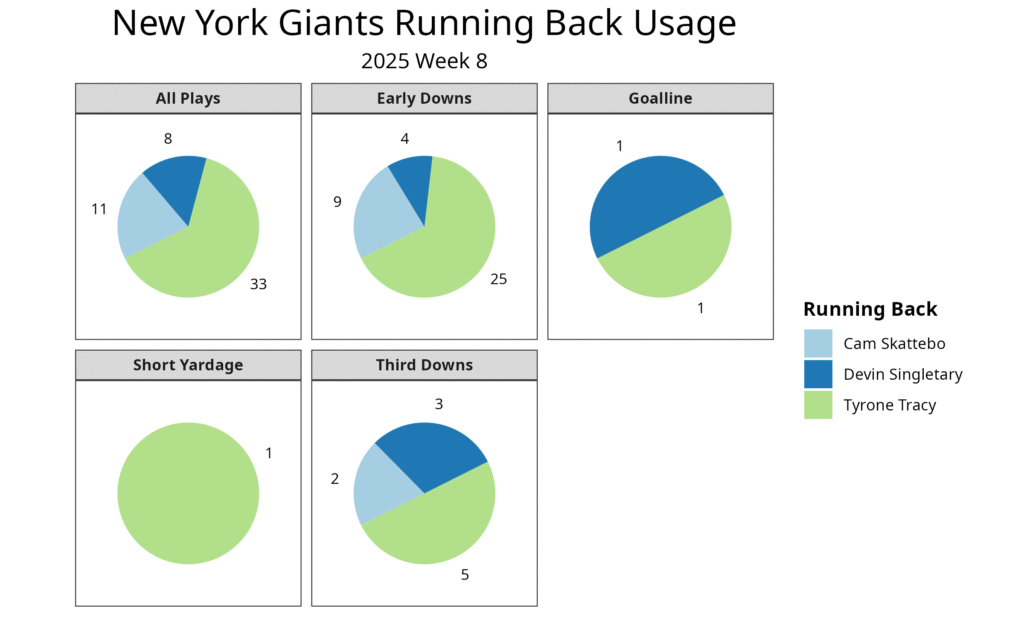
Jalin Hyatt was a healthy inactive for the Giants: Darius Slayton returned after missing the last two games due to a hamstring injury.
The Giants started the season with Malik Nabers and Darius Slayton as their every-down receivers, while Wan’Dale Robinson joined in three-receiver sets. Hyatt presumably was the top backup. This was the same rotation as 2024. Nabers suffered a season-ending injury and Slayton missed two games, which should have been an opportunity for Hyatt to step up. Robinson went to an 11-personnel receiver to an every-down receiver. However, practice squad elevation Lil’Jordan Humphrey stepped up as the second receiver, and New York shifted to much more 12 personnel, leaving Hyatt to play 25-30 offensive snaps each of the last two weeks. He caught three passes for 16 yards in Week 6 but was held without a catch this week.
Slayton was not only back this week, but he was back to his every-down role, joining Robinson. Humphrey was elevated again this week but fell to third on the depth chart, joining in three-receiver sets. Hyatt doesn’t play on special teams, so New York chose to make him inactive. If New York wants to keep using Humphrey in three-receiver sets, he will need to be signed to the 53-man roster. The Giants have also been rumored to be looking for a wide receiver. There is a chance Hyatt won’t be on the 53-man roster for New York much longer.
Monitor Saquon Barkley’s health: Barkley suffered a groin injury at the end of the third quarter. He didn’t return in the fourth quarter.
Barkley gained 150 rushing yards and scored two touchdowns on the day before the injury. The Eagles were up by multiple scores, which may have contributed to Barkley not returning. He appeared in good spirits on the sidelines after the game. The Eagles also have their bye week next week, which should give Barkley plenty of time to recover if he needs it.
Tank Bigsby played 13 of the 16 snaps in the fourth quarter. He ran nine times for 104 yards in the game, making it pretty clear that Bigsby would be the player to pick up if Barkley misses time. Will Shipley has been used more often in passing situations this season and would likely play in those situations if Barkley misses time at any point this year. A.J. Dillon was the primary backup early in the season, but he was a healthy inactive last week. Philadelphia made him active this week, but he didn’t play an offensive snap.
Bigsby could be a fine waiver-wire target in deeper leagues, but he should only be considered in most normal leagues if we find out Barkley’s injury is more serious than it currently appears.
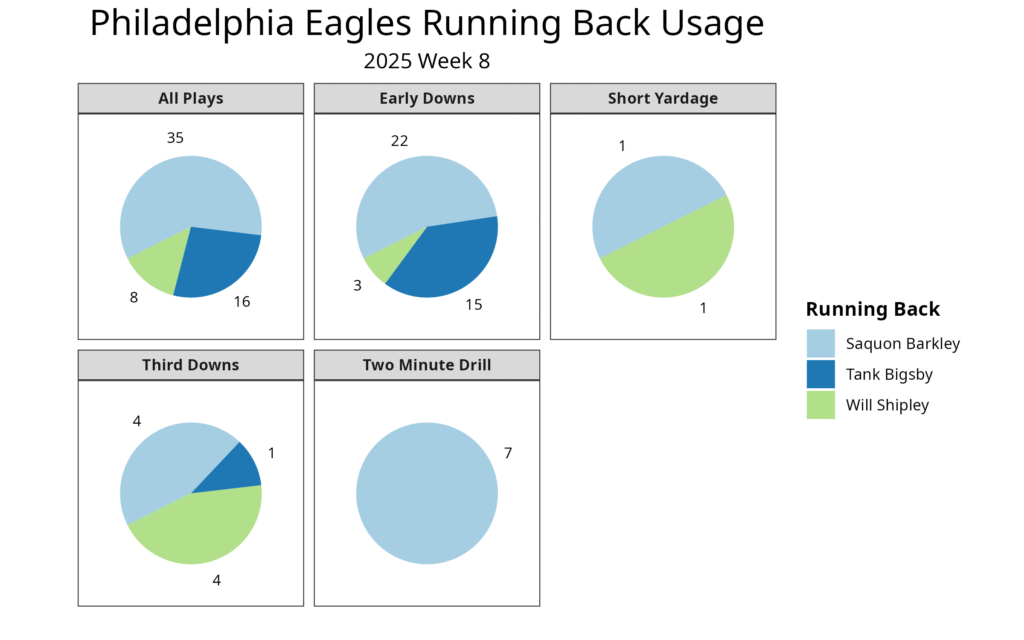
The Eagles adjust without A.J. Brown: Philadelphia’s top wide receiver didn’t practice all week due to a hamstring injury. He was ruled out on Friday.
The Eagles have spent all season using the same wide receiver rotation as last year. Brown and DeVonta Smith were the main wide receivers in two- and three-receiver sets, while Jahan Dotson joined them in three-receiver sets.
This week, Dotson became the clear second receiving option, playing in two-receiver sets. This was no surprise, considering Dotson saw an expanded role any time Brown or Smith were injured last season. The Eagles used a lot more single-receiver sets than usual, so Dotson’s total number of snaps didn’t substantially increase. Anytime one of the Eagles elite four skill players has been injured, it has just tunneled more touches to the other three players. Smith led the team in receiving with six receptions for 84 yards, while Barkley and Dallas Goedert were the only other players with multiple receptions.
Undrafted rookie Darius Cooper was activated off injured reserve on Saturday, and he emerged as the third wide receiver. He was similarly ahead of John Metchie III on the depth chart early in the season. However, neither Cooper nor Metchie received a target. Xavier Gipson played five offensive snaps, mostly in single wide receiver sets. Gipson caught his only target for three yards.
Miscellaneous Notes
- The Giants added wide receiver Ray-Ray McCloud to the practice squad on Thursday.
- New York tight end Daniel Bellinger was limited in practice all week due to a neck injury but wasn’t given a game status. Bellinger stopped playing in the third quarter due to a neck injury. The Giants stuck with 11 personnel while playing from behind, which could also have contributed to Bellinger not returning.
- The Giants activated kicker Graham Gano from injured reserve on Saturday. He was a full participant in practice all week. New York also released Jude McAtamney and brought him back to the practice squad.
- Philadelphia tight end Grant Calcaterra was back in the lineup after missing back-to-back games due to an oblique injury. He was limited in practice on Wednesday and Thursday but upgraded to full on Friday. He was back to being the clear second tight end in two-tight-end sets.
Tampa Bay Buccaneers @ New Orleans Saints
The Saints adjust without Kendre Miller: Miller suffered a season-ending knee injury last week.
Miller had been gaining more playing time from Alvin Kamara as the season progressed before the injury. Kamara was limited in practice all week due to an ankle injury. Kamara played 59% of the Saints’ offensive snaps over Weeks 5-6 compared to 78% over the first four weeks. With Miller’s injury occurring early last week, Kamara was up to 83.9% last week. Sixth-round rookie Devin Neal is the only other running back on the roster, and he played seven snaps last week.
Kamara played 67.9% in the first half this week, now that the Saints had a week to prepare Neal for a larger role. Neal was the Saints primary third-down back throughout the game. However, Kamara was the only Saints player with a designed run in the first half. The Saints started falling further behind in the third quarter, as Kamara and Neal split snaps 50-50. Neal led the Saints in snaps in the fourth quarter at 20 compared to Kamara’s 13. This left the two much closer together in snaps than many anticipated. Neal never ran the ball, but he caught three passes for 11 yards.
Neal is a fine waiver-wire target in deeper leagues. As the Saints fall further from playoff contention, it makes sense for them to play their younger players more often. There is also a slim chance Kamara gets traded.
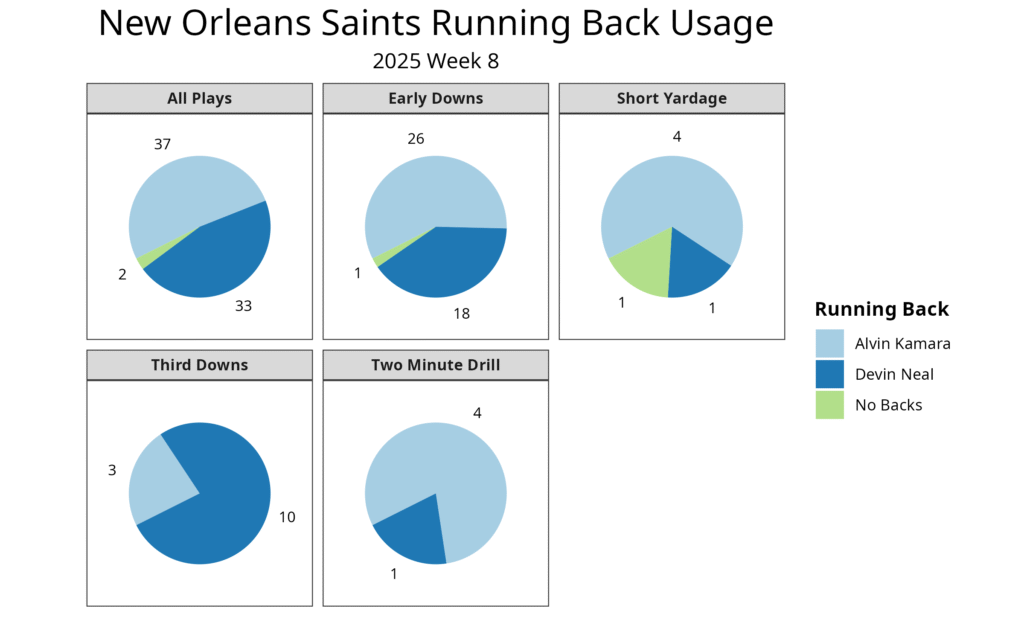
Sean Tucker takes on a larger role: Rachaad White wasn’t finding much success in the run game, leading the team to give Tucker more opportunities.
Bucky Irving didn’t practice all week and missed his fourth straight game due to foot and shoulder injuries. White had played 83.6% of Tampa Bay’s offensive snaps over the last three weeks, including 100% of the snaps on third downs and in the two-minute drill in addition to the short-yardage and goal-line snaps. Tucker took nearly all of the other snaps.
This week, the Buccaneers were focused on running the ball with White. He ran 11 times in the first half. The high number of carries led Tucker to get rotated in a little more often. White played 18 total snaps in the first half compared to Tucker’s 11. White played another 14 snaps in the second half but only ran the ball twice. Tucker ran seven times in the second half, but was only marginally more successful in the run game. The Buccaneers turned to Josh Williams to close out the game.
The Buccaneers’ bye week is next week, and it’s possible Irving will be ready for Week 10. If not, we might see more of a two-man committee with White and Tucker compared to what occurred the last three weeks.
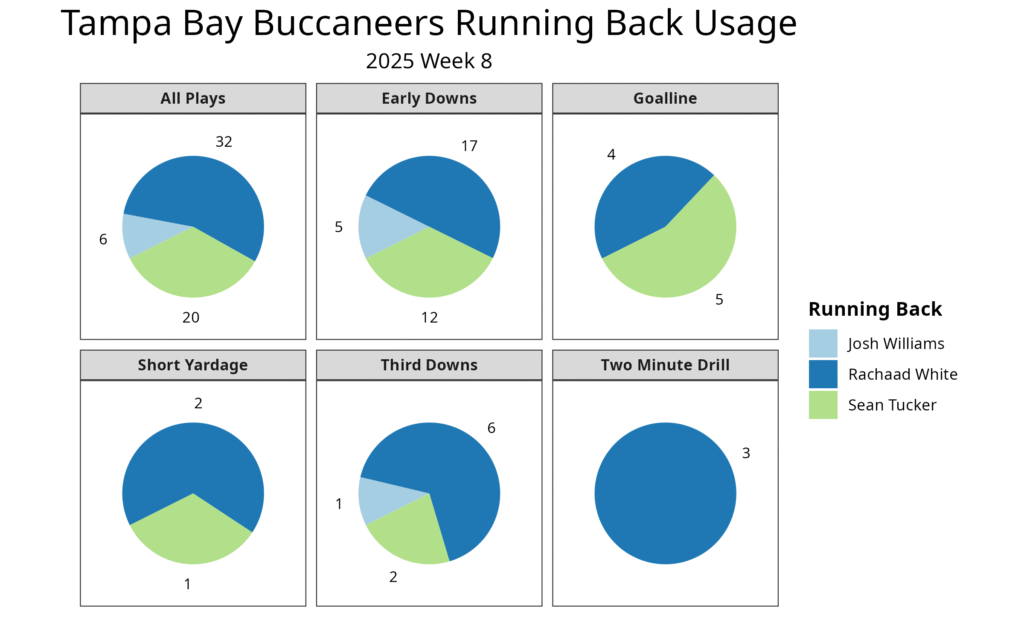
The Buccaneers continue to deal with wide receiver injuries: None of the Buccaneers’ top four wide receivers were able to practice in full this week.
The Buccaneers placed wide receiver Mike Evans on injured reserve on Wednesday due to a clavicle injury. He’s expected to miss most of the regular season. Jalen McMillan hasn’t made his season debut yet, but he will ideally return to practice in the next few weeks. Chris Godwin Jr. didn’t practice all week due to a fibula injury. He was ruled out on Friday. The only one of the top four who was able to play this week was Emeka Egbuka. He didn’t practice on Wednesday due to his hamstring injury but was upgraded to limited on Thursday and a full participant on Friday.
Egbuka played in 51 of a possible 58 snaps for Tampa Bay despite the injury. With Evans injured, Egbuka has taken over as the Buccaneers’ X receiver. He played a season low 19.6% of his snaps in the slot, after playing a previous low 22.6% last week. Egbuka has played notably better out wide compared to in the slot this season, so this should be a positive change for Egbuka.
Sterling Shepard remained the slot receiver in the three-receiver sets, as he’s been all season. Tez Johnson was the primary Z receiver in Godwin’s place, while Ryan Miller also took significant snaps, particularly in two-receiver sets. Johnson ended up leading the Buccaneers in receiving yards at 43 on five receptions. The Buccaneers have their bye week next, which could be enough time for Godwin or McMillan to recover. Once one of them is back, that will lead to much fewer snaps for Johnson. Once they are both back, that should lead to fewer snaps by Shepard.
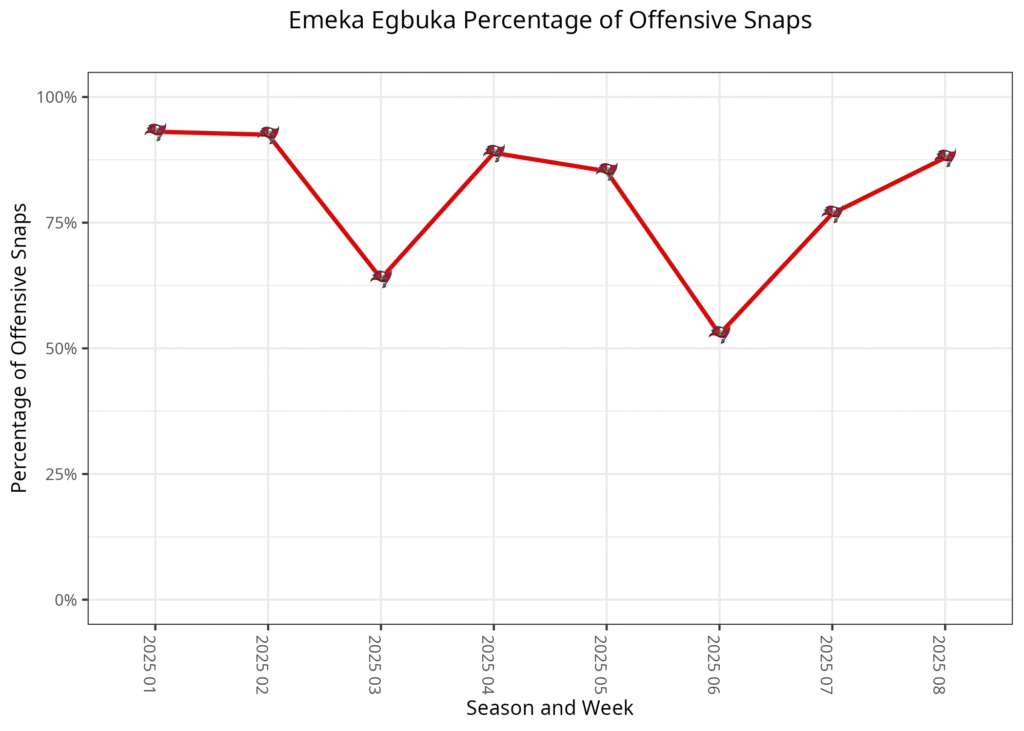
Miscellaneous Notes
- The Saints benched Spencer Rattler after throwing an interception and losing a fumble. The offense wasn’t any more successful with Tyler Shough, who also threw an interception.
- Saints’ wide receiver Chris Olave didn’t practice on Wednesday, was limited in practice on Thursday and full practice on Friday due to an ankle injury.
- Rashid Shaheed suffered an injury with one minute left in the game. Saints reporter Mike Triplett said he looked mostly OK on the sideline. Given the score of the game, it made sense that he didn’t return.
- New Orleans tight end Juwan Johnson was limited in practice on Wednesday and Thursday due to a neck injury. However, he was able to practice in full on Friday.
- The Saints claimed Zaire Mitchell-Paden off waivers from the Baltimore Ravens this week. He was a healthy inactive.
- The Saints initially signed Velus Jones Jr. off their practice squad when Kendre Miller landed on injured reserve but then released him to make room for Mitchell-Paden.
- There was some thought that Taysom Hill would play more this week with Kendre Miller on injured reserve. Instead, he only played five snaps, including two runs and one reception.
- While the Buccaneers won the game 23-3, one of their two touchdowns was from an interception. Chase McLaughlin also made three field goals of 50-plus yards, so this wasn’t as good of a game by the Buccaneers offense as the score suggested.
- Tampa Bay quarterback Teddy Bridgewater didn’t practice on Wednesday and Thursday. He was listed with an injury reason of “teeth”. He was able to practice in full on Friday, but the Buccaneers still elevated Connor Bazelak from the practice squad just in case.
- Buccaneers running back Josh Williams returned after missing the last two games due to a concussion.
Dallas Cowboys @ Denver Broncos
The Broncos tweak their wide receiver rotation: Troy Franklin has moved closer to being a reliable fantasy wide receiver.
Denver has used a frustrating wide receiver rotation this season. Courtland Sutton was the only wide receiver who played more than 65% of Denver’s offensive snaps over the first seven weeks. Ideally, any fantasy-relevant receiver would play at least 70% of his team’s offensive snaps. Troy Franklin had been at 64.4%, while Marvin Mims Jr. was at 42.7% and Pat Bryant was at 36.4%.
In recent weeks, Franklin and Bryant’s snap counts have been rising, while Mims’ has declined. That was true this week, both in terms of playing time and the box score. Franklin caught six passes for 89 yards and two touchdowns. Bryant caught two passes for 40 yards and his first touchdown. Mims was held without a catch, but he ran three times for 18 yards.
Part of Franklin’s success this week was the opponent. Ideally, his high quality of play in this game leads to an increase in snaps next week, potentially similar to earlier this season. Franklin should be a top waiver wire target in any league where he is still available.
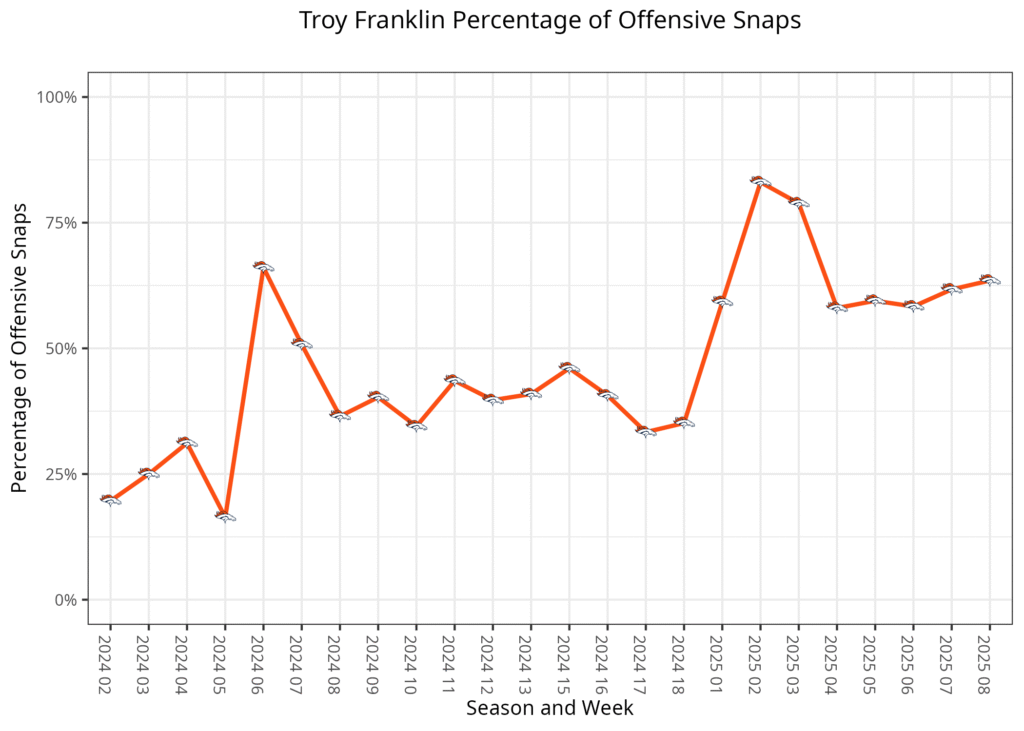
Dallas adjusts their WR3 rotation: Ryan Flournoy had the third-most offensive snaps for Dallas after taking the fifth-most last week.
The Cowboys started the year with CeeDee Lamb and George Pickens as their top two wide receivers. Jalen Tolbert and KaVontae Turpin were fighting for the third-most snaps, and both receivers played significant time. Lamb and Turpin both missed multiple weeks due to injury. While Pickens and Tolbert were the top receivers in terms of playing time, Flournoy played very well given his opportunities. In Week 5, he caught six passes for 114 yards against the New York Jets. Tolbert has never had a 100-yard game in his four-year NFL career.
Despite this, when Lamb and Turpin were healthy for Week 7, Flournoy fell to fifth, only playing 19 offensive snaps, while Tolbert played 33, and Turpin played 20. None of the three receivers made much of an impact in that game. This week, Pickens and Lamb continued to play the clear majority of the snaps. Flournoy was the one rotating with Turpin for the third spot. Tolbert played 14 offensive snaps, and nine occured in garbage time with Joe Milton III. Tolbert caught two passes for 47 yards and a touchdown, but both of his receptions occurred with Milton at quarterback.
It’s unlikely the Cowboys can sustain three fantasy-relevant receivers, but if someone else has a good game going forward, it’s much more likely it will be Flournoy or Turpin rather than Tolbert.
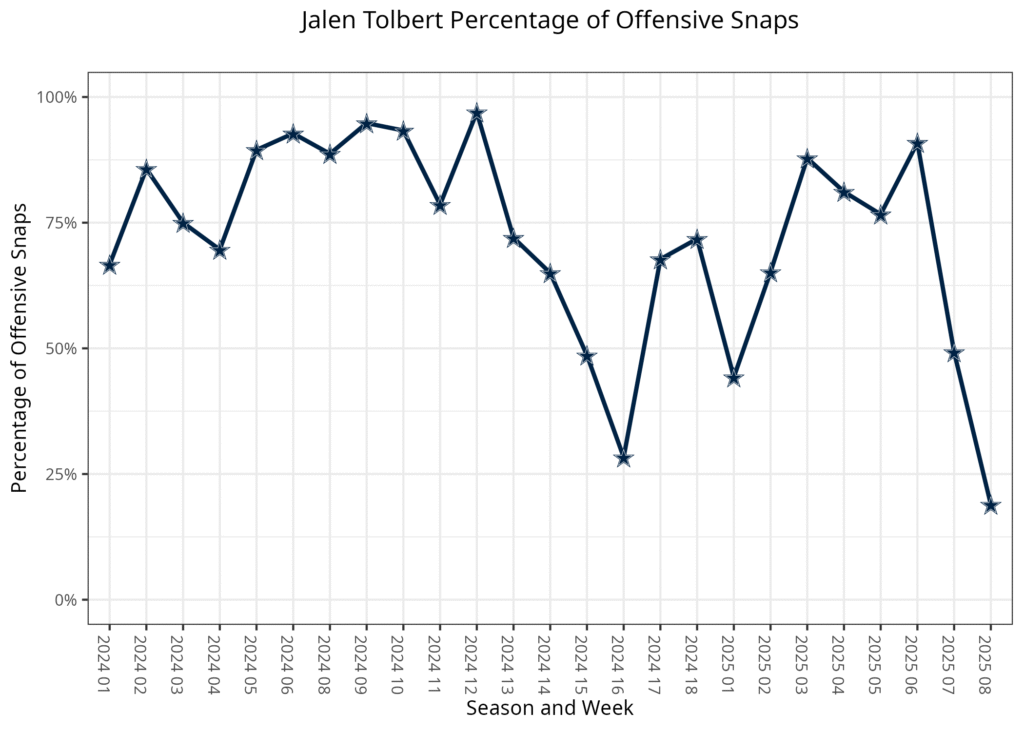
Miscellaneous Notes
- The Cowboys elevated running back Malik Davis from the practice squad for this game on Saturday, giving Dallas a third running back.
- The Cowboys activated wide receiver Jonathan Mingo from injured reserve on Tuesday because the window in which they could activate him was closing, but Dallas opted to make him inactive.
- Dallas put in backups for their final nine plays, impacting Dak Prescott, Javonte Williams, CeeDee Lamb, George Pickens and Jake Ferguson‘s playing time.
- R.J. Harvey scored three touchdowns in this game, but his role was nearly identical to the past three weeks. He’s been hovering around 25% of Denver offensive snaps. The only difference is he received three goal-line snaps, after not playing in any of the 11 goal line snaps over the last three weeks.
- Denver halfback Jaleel McLaughlin was a healthy inactive, his second straight absence. He’s been inactive every week all of the Broncos running backs have been healthy.
- Broncos run blocking tight end Nate Adkins suffered a knee injury. He was initially ruled questionable. He didn’t return, although it’s not surprising he didn’t, given the game script. If he misses time, that could open the door for more playing time for Evan Engram.
Tennessee Titans @ Indianapolis Colts
The Titans adjust without veteran wide receivers: Tyler Lockett was released on Wednesday, while Calvin Ridley missed his second straight game due to a hamstring injury.
Backup wide receiver Bryce Oliver was also ruled out due to a knee injury, his sixth straight absence. In response, the Titans signed wide receiver Mason Kinsey off their own practice squad on Friday and elevated James Proche II from the practice squad for this game.
Last week, Ayomanor played 96.2% of Tennessee’s offensvie snaps compared to Van Jefferson‘s 84.9%. Ayomanor has spent most of the season as an X receiver but moved to Z for Jefferson. Dike played 56.6% of the offensive snaps, 69% of the snaps in three-receiver sets and 14.3% of the snaos in two-receiver sets. This week, we expected a significant increase for Dike without Lockett. He played in 54 of the 57 snaps in three-receiver sets, which was a significant increase. However, he also became a primary receiver in two-receiver sets. He played nine of 13 snaps compared to Jefferson’s three of 13.
Ayomanor and Dike had similar splits to who lined up on the ball compared to who lined up off the ball whenever Jefferson wasn’t on the field. Dike caught seven passes for 93 yards this week after catching four passes for 70 yards and a touchdown last week. Given how well Dike has played, it’s possible that Dike will continue seeing snaps in two-receiver sets over Ayomanor once Ridley returns.
Dike should be among the top waiver-wire targets, thanks to his great play the last two weeks, the substantial increase in snaps, and the possibility that role continues even when Ridley is back.
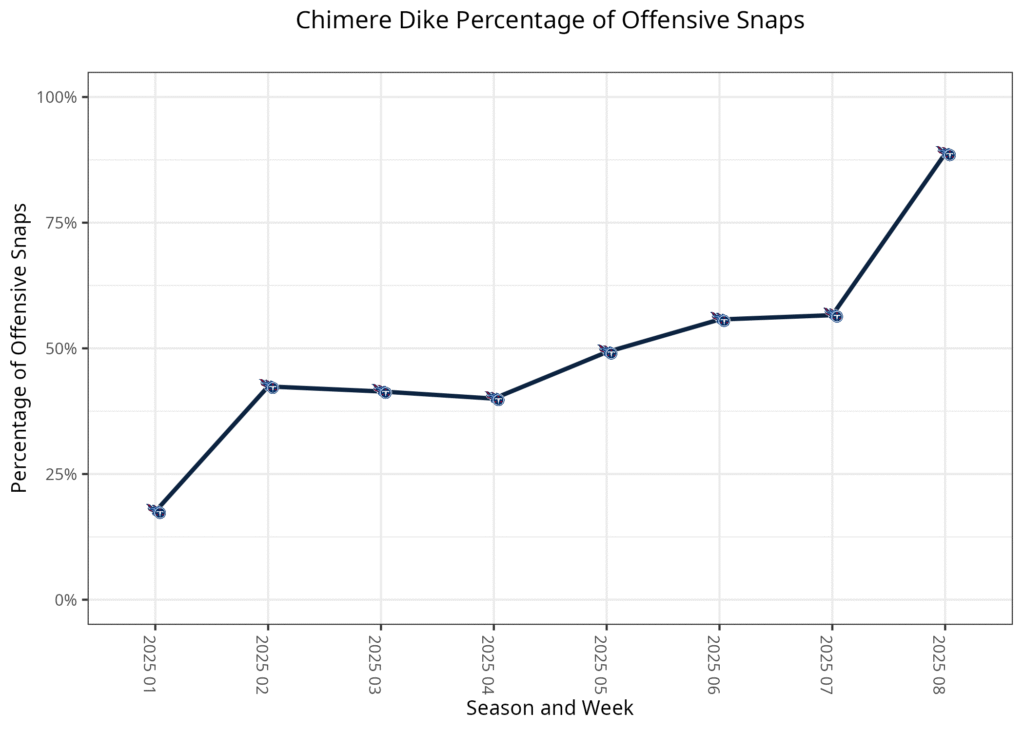
The Colts finalize their change at backup running back: Fifth-round rookie D.J. Giddens was a healthy inactive for the first time this season.
Giddens quickly won the top backup job for Indianapolis in the preseason, while Tyler Goodson dealt with injuries for most of the fall, and Khalil Herbert did not make the team. Early in September, Indianapolis removed Herbert from its practice squad, replacing him with veteran Ameer Abdullah.
Giddens was the clear backup over the first four weeks, playing 35 offensive snaps, compared to Goodson’s eight and Ulysses Bentley IV‘s two. Abdullah made his Colts debut in Week 5, while Goodson dealt with a groin injury. He played five offensive snaps. This included playing more than Giddens before garbage time, but Giddens ending up playing more snaps thanks to garbage time. In Week 6, Abdullah played more offensive snaps than Giddens because Giddens only played in garbage time. Last week, Abdullah was the primary backup, while Giddens only played in garbage time, making it even more clear that Abdullah was the lead backup.
Goodson was back this week after missing the last four, leading Giddens to be a healthy inactive. The Colts easily won, allowing Abdullah to play 10 total offensive snaps. None of this matters as long as Jonathan Taylor is healthy, but if Taylor suffers an injury, it’s even clearer now that Abdullah would be the running back to pick up. Given how much the Colts offense has relied on the run game, it could make sense to pick up Abdullah in some deeper leagues now.
Miscellaneous Notes
- Indianapolis’ slot receiver Josh Downs returned after missing last week due to a concussion. Backup Ashton Dulin (chest) was also active after missing last week. Downs was back to his usual role in the slot in three-receiver sets.
- The Colts used backups for the final six offensive snaps of the game, impacting the all the usual starters’ playing time.
- Tyjae Spears played more offensive snaps than Tony Pollard, which is typical in blowout victories. It’s worth noting he has led the team in rushing yards each of the last two weeks.
- Chigoziem Okonkwo’s playing time notably fell in Week 5, leading to more playing time by rookie Gunnar Helm. However, his playing time seems to have stabilized around 62% of the offensive snaps each of the last four games.
Green Bay Packers @ Pittsburgh Steelers
Christian Watson makes his season debut: The Packers activated wide receiver Christian Watson from the physically unable to perform list on Saturday.
Christian Watson tore his ACL at the end of last season, causing him to miss the start of this year. His return came at the right time for Green Bay, as Dontayvion Wicks was ruled out Friday with a calf injury after not practicing all week. Rookie Matthew Golden, limited in practice with a hip injury, was listed as questionable but ultimately played.
Golden saw an expanded role with Wicks sidelined, finishing second among Packers wide receivers in snap share. It marked his third straight game playing at least 90% of snaps in three-receiver sets. Green Bay used more 11 personnel than usual, helping Golden reach a season high in offensive snap percentage. Watson immediately resumed his role as the Packers’ primary Z receiver in three-wide sets, playing noticeably more than Malik Heath and Savion Williams. He and Golden split two-receiver set snaps opposite Romeo Doubs.
Christian Watson had a strong return, catching four passes for 85 yards, while Matthew Golden wasn’t much of a factor.
The Packers’ wide receiver rotation is set to become far more crowded in the coming weeks. The return of Wicks will likely cut into the snaps for both Golden and Watson, and Jayden Reed — who hasn’t played since Week 2 — is nearing a return after missing six weeks. Initial reports suggested a six- to eight-week recovery timeline, putting him on track to return within the next few weeks.
Romeo Doubs has logged at least 85% of offensive snaps in each of the past five games after playing only 70-75% in the first two weeks when Reed was active. The return of multiple receivers will likely reduce his snap share as well.
While Watson’s big-play ability might make him an appealing waiver-wire target after his first game back, the Packers’ crowded depth chart makes him a risky add. It’s likely best to leave him on the wire for now.
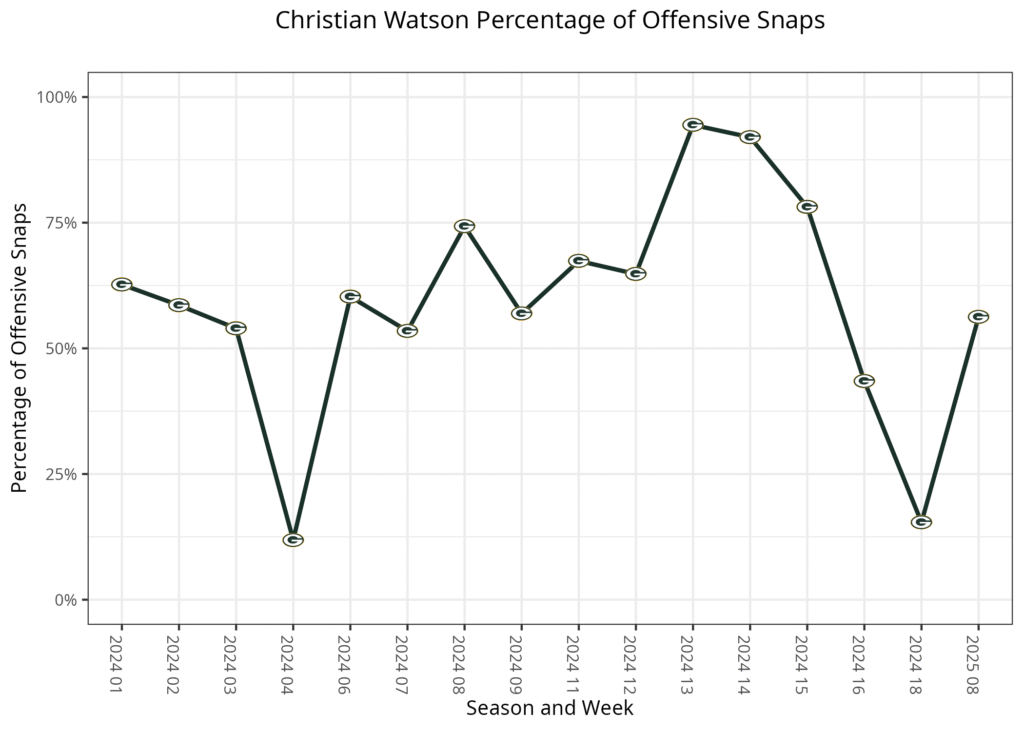
Calvin Austin III returns for the Steelers: Austin returned to his role as the Steelers’ second wide receiver.
Calvin Austin III returned to the lineup after missing two games with a shoulder injury. He was a full participant in practice throughout the week. Scotty Miller was ruled out with a finger injury after being limited on Thursday and not practicing Friday. With Miller sidelined, Austin resumed his role as the Steelers’ No. 2 wide receiver, consistently playing in three-receiver sets and logging the majority of snaps in two-receiver formations. Roman Wilson served as the third receiver in three-wide sets, while Ben Skowronek rotated in at times with Austin in two-wide looks.
Austin didn’t contribute much in the passing game, finishing with four receptions for 28 yards, but Pittsburgh’s passing attack as a whole struggled, and some rust was expected in his first game back. Before the injury, Austin averaged 9.0 PPR points per game. The Steelers face a favorable matchup against the Indianapolis Colts next week, as opponents have been forced to throw often to keep pace with their offense. Austin is a solid deep-league target for fantasy managers in need of wide receiver help.
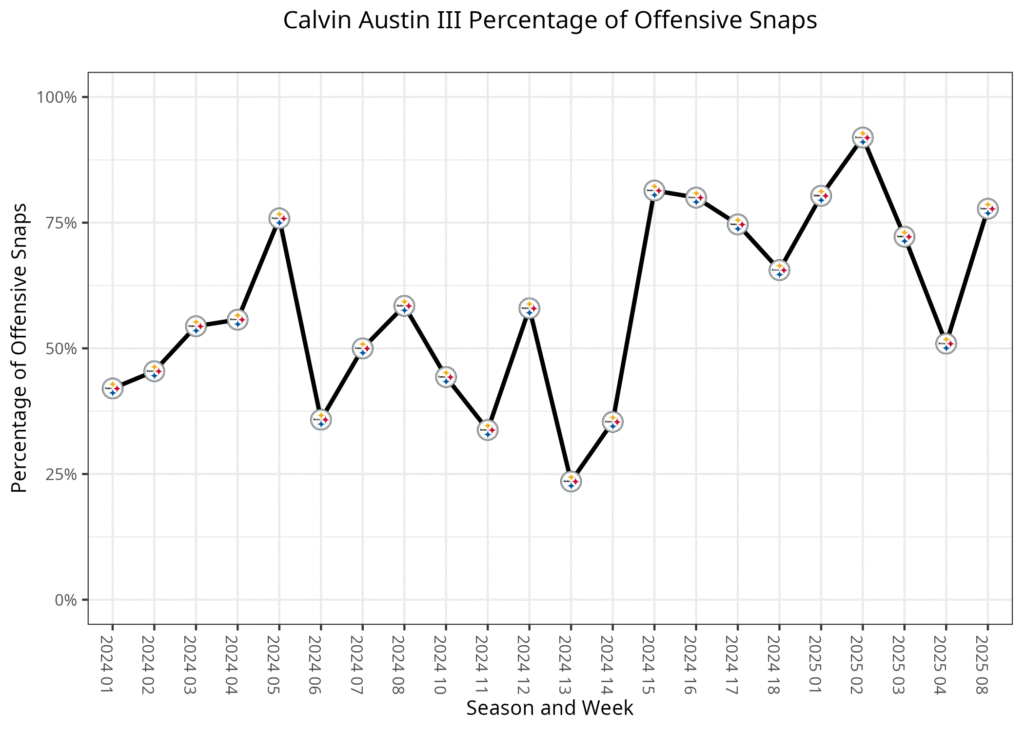
Miscellaneous Notes
- Steelers quarterback Will Howard returned to practice from injured reserve on Wednesday. He was a full participant in practice all week.
- Rookie running back Kaleb Johnson didn’t play a single offensive snap for the second consecutive week.
- Packers running back Josh Jacobs was limited in practice all week with a calf injury but wasn’t given a game status. He played 72% of snaps over the first three quarters, which is very normal for him. The Packers turned primarily to Emanuel Wilson in the fourth quarter as Jacobs wasn’t very productive in those three quarters.
- Pierre Strong Jr. was active this week after being a healthy inactive last week, giving the Packers four running backs.
- Tucker Kraft scored 33.3 PPR points, which was the most for a tight end in a game since Week 11 of 2024. Taysom Hill ran seven times for 138 yards and three touchdowns and caught eight passes for 50 yards in that game.
- The Packers waived tight end Ben Sims on Saturday.
- Green Bay kicker Brandon McManus was back in the lineup after missing back-to-back games with a right quadricep injury. This left Lucas Havrisik as a healthy in
Table notes
- Snaps include plays called back due to penalties, including offensive holding or defensive pass interference. The other three stats have these plays removed.
- Targets may differ from official NFL sources. The most likely discrepancy would be from a clear thrown-away pass, where the NFL may give the target to the nearest receiver, while this data will not.
- Carries are only on designed plays. Quarterback scrambles won’t count for the total number of carries in the game.
First Appeared on
Source link









